Trainee Successes: Past & Present
Past Highlighted Trainees

Elizabeth Wat, M.D.
Read Bio
Elizabeth Wat, M.D. is a former NIMH summer intern (2019), through the Summer Internship Program (SIP), where she first joined Dr. Peter Bandettini’s Section on Functional Imaging Methods (SFIM). Under the mentorship of Drs. Bandettini, Peter Molfese, and Emily Finn, her research focused on new ways of analyzing an archival fMRI dataset of naturalistic story reading to examine how the adult brain processes language embedding. While originally hoping to return again in 2020, the summer program was cancelled due to the pandemic. Instead, Elizabeth returned as a summer intern in 2021 after her first year of medical school. She applied the same methodological approaches of naturalistic fMRI to a dataset of early-reading children listening to stories in the fMRI. Elizabeth presented a poster on the interesting findings at the 2022 Organization for Human Brain Mapping (OHBM) conference. Based on the feedback and excitement from the poster presentation, Elizabeth continued to work on the project as a special volunteer in the lab, culminating in a paper that was recently published.
Elizabeth graduated in May 2024 with an M.D. from the University of Virginia School of Medicine. Her scholarly achievements, including her research, resulted in her induction into Alpha Omega Alpha, the national medical honor society. She is currently participating in the residency match for the field of child neurology and plans on continuing her neuroimaging research in the hopes of giving patients and families answers.
Education
M.D. – University of Virginia School of Medicine
B.A. – Neuroscience, University of Virginia
Selected Publication
Wat, E. K., Jangraw, D. C., Finn, E. S., Bandettini, P. A., Preston, J. L., Landi, N., Hoeft, F., Frost, S. J., Lau, A., Chen, G., Pugh, K. R., & Molfese, P. J. (2023). Will you read how I will read? Naturalistic fMRI predictors of emergent reading. Neuropsychologia, 193, 108763. Advance online publication. https://doi.org/10.1016/j.neuropsychologia.2023.108763

Tina Liu, Ph.D.
Read Bio
Tina Liu, Ph.D., is a cognitive neuroscientist studying visual cognition and brain plasticity. She joined Dr. Leslie Ungerleider’s Section on Neural Circuitry at NIMH as a postdoctoral fellow in 2018 and continued her postdoctoral training under Dr. Eli Merriam after the sudden passing of Dr. Ungerleider in late 2020. Prior to that, Tina completed undergraduate and master’s degrees in Dr. William Hayward’s lab at the University of Hong Kong, and her Ph.D. degree in Dr. Marlene Behrmann’s lab at Carnegie Mellon University.
During her postdoctoral training at NIMH, Tina has applied cutting-edge human neuroimaging acquisition and analysis methods, specifically 7T layer fMRI, to address fundamental questions in cognitive and affective neuroscience. This initiative has led to a productive collaboration within the intramural research program and has earned her the OFT NIMH IRP Trainee Travel Award. Furthermore, Tina has spearheaded an independent research direction aimed at understanding the nature and extent of neuroplasticity in humans. Her notable work with patients includes the study of pediatric epilepsy patients to gain insights into the long-term impact of cortical resections and adult stroke patients to understand the recovery of visual functions through training-induced mechanisms.
In 2024, Tina will be joining the faculty at the Georgetown University Medical School in their Department of Neurology and Center for Brain Plasticity and Recovery as an assistant professor. The long-term goal of her research program is to reveal core principles of neuroplasticity in healthy and clinical populations across the lifespan. Additionally, she aims to leverage this knowledge to develop better rehabilitation strategies for patients coping with brain lesions, including traumatic brain injury, stroke, brain tumor, and epilepsy surgery.
Education
Ph.D. in Psychology (Cognitive Neuroscience), Carnegie Mellon University
MPhil. in Psychology (Visual Cognition), The University of Hong Kong
BSocSc. (First Class Honors) in Psychology, Politics and Public Administration, The University of Hong Kong
Selected Publications
- Bachmann, H.P., Japee, S., Merriam, E.P.#, Liu, T.T.# (accepted). Emotion and anxiety interact to bias spatial attention. Emotion. Preprint DOI: https://osf.io/qcp34/ #Co-senior authors with equal contribution
- Liu, T.T., Fu, J.Z., Chai, Y., Japee, S., Gang, C., Ungerleider, L.G., & Merriam, E.P. (2022). Layer-specific, retinotopically-diffuse modulation in human visual cortex in response to viewing emotional facial expressive faces. Nature Communications, 13(1), 6302. DOI: https://doi.org/10.1038/s41467-022-33580-7 .
- Chai, Y., Liu, T.T., Marrett, S., Li, L., Khojandi, A., Handwerker, D. A., Alink, A., Muckli, L., Bandettini, P. A. (2021). Topographical and laminar distribution of audiovisual processing within human planum temporale. Progress in Neurobiology, 205, 102121. DOI: https://doi.org/10.1016/j.pneurobio.2021.102121
- Liu, T.T.*, Freud, E.*, Patterson, C., & Behrmann, M. (2019). Perceptual function and category-selective neural organization in children with resections of visual cortex. Journal of Neuroscience, 3160-18. DOI: https://doi.org/10.1523/JNEUROSCI.3160-18.2019 *Co-first authors with equal contribution
- Liu, T.T., Nestor, A., Vida, M., Pyles, J., Patterson, C., Yang, Y., Yang, F.N., Freud, E., & Behrmann, M. (2018). Successful reorganization of category-selective visual cortex following occipito-temporal lobectomy in childhood. Cell Reports, 24(5), 1113-1122.e6. DOI: http://doi.org/10.1016/j.celrep.2018.06.099

Emma Condy, Ph.D.
Read Bio
Emma Condy, Ph.D. is an Assistant Professor in the Department of Psychology at Hofstra University. As a trainee, her research focused on examining the feasibility of using functional near-infrared spectroscopy (fNIRS) in populations with neurodevelopmental disorders, specifically intellectual disability, to examine executive function ability in relation to repetitive behaviors. She started this work as a postdoctoral trainee and research fellow in the Neurodevelopmental and Behavioral Phenotyping Service under the mentorship of Dr. Audrey thurm from 2018-2023. Dr. Condy was a fellow in the Center on Compulsive Behaviors for the last 3 years of her training at NIMH and received the Seymour S. Kety award for clinical research in 2022.
Dr. Condy began her position as assistant professor at Hofstra University in 2023. In addition to teaching courses in statistics and neuroscience, her research program uses neuroscientific methods with low participant burden (e.g., psychophysiology, fNIRS) to investigate biomarkers of repetitive behaviors and cognitive inflexibility over the course of early development. She hopes to use both in lab and real-world recordings to uncover when and how repetitive behaviors become maladaptive or distressing and to investigate interventions targeting these behaviors when appropriate.
Education
Ph.D. in Psychology, Virginia Tech
M.S. in Psychology, Virginia Tech
A.B. in Biology & Psychology, Bryn Mawr College
Selected Publications
- Condy, E. E., Becker, L., Farmer, C., Kaat, A. J., Chlebowski, C., Kozel, B. A., & Thurm, A. (2022). NIH Toolbox Cognition Battery Feasibility in Individuals With Williams Syndrome. American Journal on Intellectual and Developmental
- Srivastava, S.*, Condy, E.*, Carmody, E., Filip-Dhima, R., Kapur, K., Bernstein, J. A., ... & Developmental Synaptopathies Consortium Sahin Mustafa Kolevzon Alexander Buxbaum Joseph D. Kravis Elizabeth Berry Soorya Latha Thurm Audrey Powell Craig Bernstein Jonathan A. Warfield Simon Dies Kira Siper Paige Hanson Ellen Phillips Jennifer M. (2021). Parent-reported measure of repetitive behavior in Phelan-McDermid syndrome. Journal of Neurodevelopmental Disorders, 13(1), 53.
- Condy, E., Kaat, A. J., Becker, L., Sullivan, N., Soorya, L., Berger, N., ... & Thurm, A. (2021). A novel measure of matching categories for early development: Item creation and pilot feasibility study. Research in developmental disabilities, 115, 103993.
*denotes co-first authors
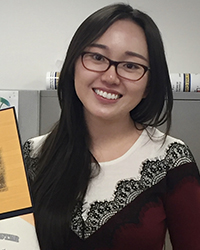
Maya Zhe Wang, Ph.D.
Read Bio
Maya Zhe Wang, Ph.D., was a postdoctoral fellow in the Section on the Neurobiology of Learning and Memory led by Dr. Betsy Murray, at the NIMH, between 08/2020 and 03/2022. Dr. Wang's research focused on combining large-scale electrophysiology and optogenetics in nonhuman primates to study the causal and neuro-computational involvement of medial prefrontal cortex in reward-based decision-making.
Dr. Wang is currently a Senior Data Scientist at the Cigna Group. Her current work involves developing predictive models for recommending preventive care and interventions to customers and health care providers to steer at-risk individuals away from disastrous health events. Her goal is to develop, evaluate, and test cutting-edge artificial intelligence models to improve health care.
Education
Ph.D. in Neuroscience, University of Minnesota
M.A. in Brain and Cognitive Sciences, University of Rochester
B.S. in Psychology, Kansas State University
B.Ed., South China Normal University
Selected Publications
- Wang, M. Z., Hayden, B. Y., & Heilbronner, S. R. (2022). A structural and functional subdivision in central orbitofrontal cortex. Nature communications,13(1), 3623.
- Maisson, D. J. N., Cash-Padgett, T. V., Wang, M. Z., Hayden, B. Y., Heilbronner, S. R., & Zimmermann, J. (2021). Choice-relevant information transformation along a ventrodorsal axis in the medial prefrontal cortex. Nature communications, 12(1), 4830.
- Maisson, D. J., Fine, J. M., Yoo, S. B. M., Cash-Padgett, T. V., Wang, M. Z., Sleezer, B. J., ... & Hayden, B. Y. (2021). Orthogonal but linked neural codes for value. bioRxiv, 2021-07.
- Cervera, R. L., Wang, M. Z., & Hayden, B. Y. (2020). Systems neuroscience of curiosity. Current Opinion in Behavioral Sciences, 35, 48-55.

Maia Pujara, Ph.D.
Read Bio
Maia Pujara, Ph.D., is a former NIMH Research Fellow (2016-2020) in the Laboratory of Neuropsychology in the Section on the Neurobiology of Learning and Memory with Dr. Elisabeth (Betsy) Murray, the Section Chief. Her research focused on the functional interaction between the orbitofrontal cortex and the amygdala in goal-oriented decision making, value updating, emotion regulation, and social cognition. She worked primarily with a lesion model to assess the causal role of these regions, in conjunction with behavioral testing, psychophysiological measurements, and functional neuroimaging. To support this work, Maia was awarded an intramural fellowship through the Center on Compulsive Behaviors , and a Professional Development Award from the Society for Neuroscience’s Neuroscience Scholars Program for underrepresented early career researchers in neuroscience.
Before coming to the NIH, Maia completed her undergraduate training in Neuroscience with a double major in English at Furman University in Greenville, SC (2006-2010). Maia obtained her Ph.D. in Michael Koenigs’s lab at the University of Wisconsin-Madison (2010-2016), where she investigated the causal role of the ventromedial prefrontal cortex in neurological patients with permanent focal brain damage. She recently joined the Psychology Department at Sarah Lawrence College, a small liberal arts school in Bronxville, NY, as an Assistant Professor, where she teaches courses at the intersection of psychology, neuroscience, and biological systems. Her current research assesses the effect of behavioral interventions from the field of positive psychology on decision-making and emotional and autonomic regulation in college-aged students, to support psychological safety, coping, resilience, and general wellbeing. Her goal is to expand hands-on research training opportunities for undergraduates in neuroscience.
Education
Ph.D. in Neuroscience, University of Wisconsin-Madison
B.S. in Neuroscience & English, Furman University
Selected Publications
- Pujara, M. S., Ciesinski, N. K., Reyelts, J. F., Rhodes, S. E. V., & Murray, E. A. (2022). Selective prefrontal-amygdala circuit interactions underlie social and nonsocial valuation in rhesus macaques. The Journal of Neuroscience, 42(28), 5593–5604. https://doi.org/10.1523/JNEUROSCI.0794-21.2022
- Taswell, C. A., Costa, V. D., Basile, B. M., Pujara, M. S., Jones, B., Manem, N., Murray, E. A., & Averbeck, B. B. (2021). Effects of Amygdala Lesions on Object-Based Versus Action-Based Learning in Macaques. Cerebral Cortex, 31(1), 529–546. https://doi.org/10.1093/cercor/bhaa241
Vaidya, A. R.*, Pujara, M. S.*, Petrides, M., Murray, E. A., & Fellows, L. K. (2019). Lesion Studies in Contemporary Neuroscience. Trends in Cognitive Sciences, 23(8), 653–671. https://doi.org/10.1016/j.tics.2019.05.009
*Equal contribution first authors
- Pujara, M. S., Rudebeck, P. H., Ciesinski, N. K., & Murray, E. A. (2019). Heightened Defensive Responses Following Subtotal Lesions of Macaque Orbitofrontal Cortex. The Journal of Neuroscience, 39(21), 4133–4141. https://doi.org/10.1523/JNEUROSCI.2812-18.2019

Amicia Elliott, Ph.D.
Read Bio
Amicia Elliott, Ph.D. is a biophysicist whose research focused on developing genetic, computational, and custom-built imaging tools to study the hormonal control of movement at cellular resolution in the fruit fly brain and muscles. She performed this work as a postdoctoral and research fellow in Benjamin White’s lab co-mentored by Hari Shroff, which she began in 2014. Dr. Elliott completed undergraduate training at Purdue University with a major in Genetic Biology and a master’s degree in Genetics and Molecular Biology at the University of Alabama in Huntsville. She completed her Ph.D. with David Piston at Vanderbilt University in Molecular Physiology and Biophysics.
Dr. Elliott’s NIH research had two main tracks focused on a critical developmental fruit fly behavior that is driven by a hormonally governed neural circuit. She was awarded a NIGMS PRAT Fellowship to build a light-sheet microscope capable of multicolor brain-wide imaging in the fruit fly at cellular resolution. This system is used to study multiple neuronal populations in the governing neural circuit by imaging calcium dynamics in response to hormonal stimuli. Secondly, Dr. Elliott characterized the dynamics, at single-muscle fiber resolution, of a behaving pupal fruit fly during the developmental behavior. This effort was facilitated by the identification of a novel gene expressed selectively in the striated muscle, which she named hlk (hulk). For this combined work she received a Fellows’ Award for Research Excellence in 2017 and 2018 and was awarded the NIMH Julius Axelrod Memorial Fellowship Award in 2019.
In 2022, Dr. Elliott joined Colossal Biosciences as the first Product Manager for software to develop a computational platform in support of their woolly mammoth de-extinction mission. Colossal spun out the software product suite as an independent company, Form Bio, and currently, Dr. Elliott is a Senior Product Manager there, where she continues to develop computational products for the life sciences.
Education
Ph.D. in Molecular Physiology and Biophysics, Vanderbilt University
M.S. in Genetics and Molecular Biology, University of Alabama in Huntsville
B.S. in Genetic Biology, Purdue University
Selected Publications
- Elliott, A.D., Berndt, A. Houpert, M., Roy, S., Scott, R.L., Chow, C.C., Shroff, H., White, B.H. (2021). Pupal behavior emerges from unstructured muscle activity in response to neuromodulation in Drosophila. Elife, 10, e68656. doi: 10.7554/eLife.68656
- Elliott, A.D. (2020). Confocal microscopy: principles and modern practices. Current protocols in cytometry, 92 (1), e68. doi: 10.1002/cpcy.68
- Diao, F., Elliott, A.D., Diao, F., Shah, S., White, B.H. (2017). Neuromodulatory connectivity defines the structure of a behavioral neural network. Elife, 6, e29797. doi: 10.7554/eLife.29797

Peter H. Rudebeck
Read Bio
Dr. Peter Rudebeck is a neuroscientist who studies how parts of the frontal cortex and limbic system guide our behavior and regulate affect. He joined Dr. Elisabeth Murray’s Section on Neurobiology of Learning and Memory at the NIMH in early 2007 as a visiting postdoctoral research fellow. Prior to that, Peter received his undergraduate degree from the University of Nottingham and a Master’s from the University of Oxford. He completed his DPhil. also at the University of Oxford where he worked with Drs. Matthew Rushworth and Davide Bannerman before joining NIMH.
Now an Associate Professor of neuroscience and psychiatry at the Icahn School of Medicine at Mount Sinai, Peter’s work is focused on two main themes. One theme involves determining how parts of ventral frontal cortex and amygdala interact during decision making to optimally guide decision making. The second theme is focused on determining how circuits that connect to the subcallosal anterior cingulate cortex interact to regulate emotion in health and disease. For this latter theme, he works closely with clinicians who are working to develop novel therapeutic approaches for treatment-resistant psychiatric disorders. He has received a number of awards for his work while at the NIH and as an independent researcher including the Julius Axelrod Memorial Fellowship from the NIMH, an NIMH BRAINS Award, and the Janet Rosenberg Trubach Career Development Award from the Society for Neuroscience.
Education
BSc in Psychology, University of Nottingham
MSc in Neuroscience, University of Oxford
DPhil in Experimental Psychology, University of Oxford
Publications
- Elisabeth A. Murray and Peter H. Rudebeck (2018) Specializations for value-based decision making in the primate ventral prefrontal cortex. Nature Reviews Neuroscience, 19(7): 404-417
- Peter H. Rudebeck, Richard C. Saunders, Dawn A. Lundgren, and Elisabeth A. Murray (2017) Specialized representations of value in orbital and ventrolateral prefrontal cortex: desirability versus availability of outcomes. Neuron, 95(5): 1208-1220
- Peter H. Rudebeck, Joshua A. Ripple, Andrew R. Mitz, Bruno B. Averbeck, and Elisabeth A. Murray (2017) Amygdala contributions to stimulus–reward encoding in the macaque medial and orbital frontal cortex during learning. Journal of Neuroscience, 37(8): 2186-2202
- Andrew R. Mitz, Ravi V. Chako, Philip T. Putnam, Peter H. Rudebeck, and Elisabeth A. Murray (2017) Using pupil size and heart rate to infer affective states during behavioral neurophysiology and neuropsychology experiments. Journal of Neuroscience Methods, 279:1-12
- Anthony I. Jang, Vincent D. Costa, Peter H. Rudebeck, Yogita Chudasama, Elisabeth A. Murray, and Bruno B. Averbeck (2015) The role of frontal cortical and medial-temporal lobe brain areas in learning a Bayesian prior belief on reversals, Journal of Neuroscience, 35(33): 11751-11760
- Peter H. Rudebeck and Elisabeth A. Murray (2014) The orbitofrontal oracle: cortical mechanisms for predicting and evaluating specific behavioral outcomes. Neuron84(6): 1143-1156
- Tianming Yang, Rachel Bavley, Kevin Fomalont, Kevin Blomstrom, Andrew R Mitz, Janita Turchi, Peter H Rudebeck and Elisabeth A Murray (2014) Contributions of the hippocampus and entorhinal cortex to rapid associative learning in rhesus monkeys. Hippocampus, 24(9): 1102-11
- Peter H Rudebeck*, Philip T Putnam*, Teresa E Daniels, Tianming Yang, Andrew R Mitz, Sarah EV Rhodes and Elisabeth A Murray (2014) A role for primate subgenual cingulate cortex in sustaining autonomic arousal. Proceedings of the National Academy of Sciences of the USA, 111(14): 5391-6
- Peter H Rudebeck, Andrew R Mitz, Ravi V Chacko and Elisabeth A Murray (2013) Effects of amygdala lesions on reward-value coding in orbital and medial prefrontal cortex. Neuron, 80(6): 1519-31
- Peter H Rudebeck, Richard C Saunders, Anna T. Prescott, Lily S. Chau and Elisabeth A Murray (2013) Prefrontal mechanisms of emotion, value and behavioural flexibility. Nature Neuroscience, 16(8): 1140-5
- Elisabeth A Murray and Peter H Rudebeck (2013) Strive to drive: goal generation based on current needs. Frontiers in Neuroscience, 7: 112
- Yogita Chudasama, Teresa E Daniels, Daniel P Gorrin, Sarah EV Rhodes, Peter H Rudebeck, and Elisabeth A Murray (2013) Anterior cingulate cortex lesions in rhesus monkeys fail to disrupt choices guided by changes in reward value and reward contingency. Cerebral Cortex, 23(12): 2884-98
- Peter H Rudebeck and Elisabeth A Murray (2011) Balkanizing the primate orbitofrontal cortex: distinct subregions for comparing and contrasting values. Annals of the New York Academy of Sciences, 1239(1): 1-13
- Peter H Rudebeck and Elisabeth A Murray (2011) Dissociable effects of subtotal lesions within the macaque orbitofrontal cortex on reward-guided behaviour. Journal of Neuroscience, 31(29): 10569-10578
- Peter H Rudebeck, Elisabeth A Murray (2008) Amygdala and orbitofrontal cortex lesions differentially influence choices during object reversal learning. Journal of Neuroscience, 28(33): 8338–8343

Adrian Gilmore, Ph.D.
Read Bio
Adrian Gilmore, Ph.D., is a cognitive neuroscientist who investigates how we retrieve information from our long-term memories. He is currently a Research Fellow in Alex Martin’s Section on Cognitive Neuropsychology in the Laboratory of Brain and Cognition at the NIMH, which he joined in 2016. Adrian completed his undergraduate training at Colby College in Waterville, ME, where he double majored in Psychology with a neuroscience concentration and Classical Civilizations. Adrian completed his Ph.D. in Kathleen McDermott’s lab at Washington University in St. Louis.
Adrian’s research has followed two main themes. One involves the study of neural systems that enable us to remember and re-experience events from our past in the form of autobiographical memories. He separately investigates how repeated exposures to specific stimuli change the way they are processed in the brain. Adrian’s work has been recognized with several awards, including an NSF Graduate Research Fellowship in 2011, an NIH Fellows Award for Research Excellence in 2020, the NIMH Julius Axelrod Memorial Fellowship Award in 2021, and a Rising Star award from the Association for Psychological Science in 2023. In 2024, Adrian will be joining the faculty at the University of Delaware in their Department of Psychological and Brain Sciences as an assistant professor. There, his work will continue to focus on human memory to better understand the cognitive and neural systems that support it.
Education
PhD in Psychological and Brain Sciences, Washington University in St. Louis
AM in Psychology, Washington University in St. Louis
BA in Psychology (Neuroscience) & Classical Civilizations, Colby College
Selected Publications
- Gilmore, A.W., Quach, A., Kalinowski, S.E., González-Araya, E.I, Gotts, S.J., Schacter, D.L., & Martin, A. (2021). Evidence supporting a time-limited hippocampal role in retrieving autobiographical memories. Proceedings of the National Academy of Sciences of the United States of America, 118, e2023069118. doi: 10.1073/pnas.2023069118
- Gilmore, A.W., Quach, A., Kalinowski, S.E., Gotts, S.J., Schacter, D.L., & Martin, A. (2021). Dynamic content reactivation supports naturalistic autobiographical recall in humans. Journal of Neuroscience, 41, 153-166. doi: 10.1523/jneurosci.1490-20.2020
- Gilmore, A.W., Kalinowski, S. E., Milleville, S., Gotts, S.J., & Martin, A. (2019). Identifying task-general effects of stimulus familiarity in the parietal memory network. Neuropsychologia, 124, 31-43. doi: 10.1016/j.neuropsychologia.2018.12.023
- Silson, E.H.*, Gilmore, A.W.*, Kalinowski, S.E., Steel, A., Martin, A., & Baker, C.I. (2019) A posterior-anterior distinction between scene perception and scene construction in human medial parietal cortex. Journal of Neuroscience, 39, 705-717. doi: 10.1523/jneurosci.1219-18.2018
*Equal contribution first authors
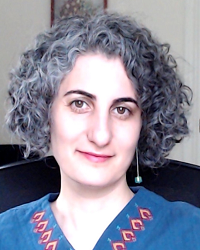
Maryam Vaziri-Pashkam, M.D., Ph.D.
Read Bio
Maryam Vaziri-Pashkam, M.D., Ph.D. is a cognitive neuroscientist interested in the intersection of visual cognition and action. She has completed her medical training at Tehran University of Medical Sciences and her Ph.D. training in cognitive psychology at Harvard University. After finishing her Ph.D., she worked as a post-doctoral fellow at Harvard University and then joined Dr. Leslie Ungerleider’s lab at NIMH. Since the unfortunate passing of Dr. Ungerleider, she has continued as a research fellow in the lab of Dr. Chris Baker at the Laboratory of Brain and Cognition. During her stay at NIMH, with the help of her supervisors, she ran a relatively independent research program that has led to several publications, with her as the senior author. She has also received a FARE award for her research. She has accepted an offer to become an assistant professor at the Department of Psychological and Brain Sciences at the University of Delaware from August 2023.
Her research aims to advance our understanding of the computational and neural mechanisms that enable real-time interaction with objects and people. In the past, she has established the existence of robust representations for objects and actions in the human parietal cortex, a region that bridges visual and motor areas of the brain that enables interaction with objects. She has also demonstrated humans’ remarkable prediction ability during real-time social interactions. In the future, she will continue delineating the neural circuitry and mechanisms involved in extracting object shapes and human body movements during natural interactions. To do this, she combines multiple methodologies, including body movement tracking, collection, and analysis of large datasets of human behavior in naturalistic settings, neuroimaging, and computational methods such as machine learning and natural language processing to obtain a deeper understanding of visual processing that applies better to everyday settings.
Education
Ph.D., Psychology, Harvard University
M.A., Psychology, Harvard University
M.D., Department of Medicine, Tehran University of Medical Sciences
Selected Publications
- Roberts S, Ungerleider L, Vaziri-Pashkam M, (2023) Disentangling object category representations driven by dynamic and static visual input. Journal of Neuroscience. 43(4),
- Yargholi E, Hossein-Zadeh GA, Vaziri-Pashkam M, (2022) Two distinct networks containing position-tolerant representations of actions in the human brain. Cerebral Cortex, bhac149.
- Xu Y, Vaziri-Pashkam M, (2021) Limits to visual representational correspondence between convolutional neural networks and the human brain. Nature Communications. 12 (1), 1-16.
- McMahon E, Kim D, Mehr SA, Nakayama K, Spelke E, Vaziri-Pashkam M, (2021) The ability to predict actions of others from distributed cues is still developing in children. Journal of Vision, 21 (5), 14-14.
- McMahon EG, Zheng CY, Pereira F, Gonzalez R, Ungerleider LG, Vaziri-Pashkam M, (2019) Subtle predictive movements reveal actions regardless of social context. Journal of Vision, 19(7), 16-16.
- Vaziri-Pashkam M, Xu Y, (2019) An information-driven 2-pathway characterization of occipitotemporal and posterior parietal visual object representations. Cerebral Cortex, 29:2034-2050.

John “JJ” O’Malley, Ph.D.
Read Bio
John “JJ” O’Malley, Ph.D., is a behavioral neuroscientist investigating how inhibition of the thalamus shapes the selection of anxiety-related behaviors. He completed his undergraduate training with a double major in Psychology and Philosophy and then a masters in experimental psychology from James Madison University. After a year as a laboratory technician in Jeremy Day’s lab at the University of Alabama Birmingham he entered the Graduate School of Biomedical Sciences at the University of Texas Health Science Center at Houston. There he joined Dr. Michael Beierlein’s lab to study the cellular and circuit mechanisms in the thalamic reticular nucleus (TRN) that shape slow sleep-like oscillatory activity in the thalamus.
In 2020, JJ joined Dr. Mario Penzo’s lab unit on the neurobiology of affective memory at the NIMH. Currently in his postdoc, JJ is studying how inhibition of the thalamus shapes the expression and selection of anxiety-related behaviors. Specifically, JJ is investigating how the TRN inhibits the midline thalamus to shape avoidance behaviors. Recently, he was awarded the postdoctoral research and training fellowship or PRAT by NIGMS to further pursue his work. JJ strives to become an independent researcher as well as a mentor and teacher to the next generation of neuroscientists after his postdoctoral training.
Education
Ph.D., Neuroscience, University of Texas Health Science Center at Houston
M.A., Experimental Psychology, James Madison University
B.A., Psychology and Philosophy, James Madison University
Selected Publications
- Engelke, D. S., Zhang, X. O., O’Malley, J. J., Fernandez-Leon, J. A., Li, S., Kirouac, G. J., Beierlein, M., & Do-Monte, F. H. (2021). A hypothalamic-thalamostriatal circuit that controls approach-avoidance conflict in rats. Nature communications, 12(1), 1-19.
- O’Malley, J. J., Seibt, F., Stephens, G. Chin, J., & Beierlein, M. (2020). TRPM4 conductances in thalamic reticular nucleus neurons generate persistent firing during slow oscillations. Journal of Neuroscience 40(25) 4813-4823.
- Wickens, A., Avants. B., Verma, N., Lewis, E., Chen, J., Feldman, A., Dutta, S., Chu, J., O’Malley J. J., Beierlein, M., Kemere, K., & Robinson, J. T. (2020) Magnetoelectric materials for miniature, wireless neural stimulation at therapeutic frequencies. Neuron 107(4) 631-643.

Rany Abend, Ph.D.
Read Bio
Rany Abend, Ph.D., is a clinical neuroscientist studying psychopathology and treatment mechanisms in youth and adults with anxiety and other disorders. He completed master’s degrees in psychobiology and in clinical psychology at Tel Aviv University. He then received his Ph.D. in psychology, also from Tel Aviv University, after using cognitive neuroscience methods to study biases in information processes in anxiety and post-traumatic stress disorder.
In 2016, Dr. Abend joined Dr. Daniel Pine’s group in the Section on Development and Affective Neuroscience at the NIMH, where he used diverse clinical neuroscience techniques to study the aberrant expression and underlying pathophysiology, of fear responses in anxiety and other disorders.
In 2019, Dr. Abend received the NIMH’s Kety Memorial Fellowship Award and in 2020 he received a NARSAD Young Investigator award – both to fund research linking neuroscience, psychopathology, and treatment, to identify neural circuitry that could serve as a treatment target for pediatric anxiety.
In 2022, Dr. Abend joined the faculty of the School of Psychology at Reichman University, Israel, as a PI. Continuing his prior work, his group uses tools from neuroscience to understand pathophysiological mechanisms in anxiety and other disorders.
Education
Ph.D., Psychology, Tel Aviv University
M.A., Clinical Psychology, Tel Aviv University
M.A., Psychobiology, Tel Aviv University
B.Sc., Computer Science, Tel Aviv University
Selected Publications
- Abend, R., Ruiz, S. G., Bajaj, M. A., Harrewijn, A., Linke, J. O., Atlas, L. Y., Winkler, A. M., & Pine, D. S. (2022). Threat imminence reveals links among unfolding of anticipatory physiological response, cortical-subcortical intrinsic functional connectivity, and anxiety. Neurobiology of Stress, 16:100428.
- Abend, R.*, Burk*, D., Ruiz, S. G., Gold, A., Napoli, J. G., Britton, J. C., Michalska, K. J., Winkler, A. M., Leibenluft, E., Pine, D. S., & Averbeck, B. B. (2022). Computational Modeling of Threat Learning Reveals Links with Anxiety and Neuroanatomy in Humans. eLife, 11:e66169.
- Linke, J. O., Abend, R., Kircanski, K., Stavish, C., Clayton, M., Benson, B. E., Brotman, M. A., Renaud, O., Smith, S. S., Nichols, T. E., Leibenluft, E., Winkler, A. M., & Pine, D. S. (2022). Shared and anxiety-specific pediatric psychopathology dimensions manifest distributed neural correlates. Biological Psychiatry, 89(6).
- Abend, R., Bajaj, M., Coppersmith, D. L., Kircanski, K., Haller, S. P., Cardinale, E. M., Salum, G. A., Wiers, R. W., Salemink, E., Pettit, J. W., Perez-Edgar, K., Lebowitz, E., Silverman, W., K., Bar-Haim, Y., Brotman, M. A., Leibenluft, E., Fried, E. I., & Pine, D. S. (2021). A computational network perspective on pediatric anxiety. Psychological Medicine, 51(10).
- Abend, R., Gold, A., Britton, J. C., Michalska, K. J., Shechner, T., Winkler, A. M., Leibenluft, E., Averbeck, B. B., & Pine, D. S. (2020). Anticipatory Threat Responding: Relationships with Anxiety, Development, and Brain Structure. Biological Psychiatry, 87(10).
- Gold, A., Abend, R., Britton, J., Behrens, B., Leibenluft, E., & Pine, D. S. (2020). Age differences in the neural correlates of anxiety disorders: An fMRI study of response to learned threat. American Journal of Psychiatry, 177(5).

Julia Linke, Ph.D.
Read Bio
Julia Linke, Ph.D., integrates clinical and developmental psychology with a cognitive neuroscience perspective to examine brain-behavior mechanisms that underlie alterations in emotion-cognition interactions characteristic of mood and anxiety disorders. During her diploma, she worked in the laboratory of Dr. Clemens Kirschbaum at Dresden University, studying the effects of antenatal stress on mental health and well-being in middle childhood. Her graduate work at the Central Institute of Mental Health in Germany under the mentorship of Dr. Michèle Wessa focused on cognitive flexibility and reward processing in individuals with and at risk for bipolar disorder and depression. To study the relevant neural circuitry, Dr. Linke obtained a solid foundation in the fundamentals of task-based and resting-state functional magnetic resonance imaging and diffusion tensor imaging, including an appreciation for the future potential of these techniques. In 2017, Dr. Linke joined the Section on Mood Dysregulation and Neuroscience with Dr. Ellen Leibenluft. During her postdoctoral work, Dr. Linke has been broadening and deepening her skills in human neuroimaging while examining childhood and adolescence as sensitive neurodevelopmental periods for the emergence of mood and anxiety disorders.
In December 2022, Dr. Linke will begin an assistant professorship in the Department of Psychiatry and Behavioral Sciences at The University of Texas Health Science Center at Houston. Here, she will study the neural mechanisms adolescents use to process emotionally and motivationally relevant information and how these mechanisms are shaped by social context (e.g., adverse life events, inequity). The long-term goal of her work is to develop targeted, early interventions to mitigate youth's risk for future socioemotional problems and impairment.
Education
License, Cognitive Behavioral Therapy, Center for Psychological Psychotherapy, Heidelberg University, Germany
Ph.D., Clinical Psychology, Heidelberg University, Dresden
Diploma, Psychology, Technical University Dresden, Germany
Selected Publications
- Linke, J.O., Haller, S.P., Xu, E., Nguyen, L., Chue, A., Zapp, C., Revzina, O., Perlstein, S., Ross, A., Tseng, W.-L., Shaw, P., Brotman, M., Pine, D.S., Gotts, S.J., Leibenluft, E.*, Kircanski, K.* (revise and resubmit) Frustration-induced reconfiguration of brain networks: Implications for pediatric psychopathology. https://www.medrxiv.org/content/10.1101/2021.11.07.21266032v1
- Linke, J.O., Abend, R., Kircanski, K., Clayton, M., Stavish, C., Benson, B., Brotman, M.A., Renaud, O., Smith, S.M., Nichols, T.E., Leibenluft, E., Winkler, A., Pine, D.S. (2021) Shared and anxiety-specific pediatric psychopathology dimensions manifest distributed neural correlates. Biological Psychiatry, 86(6). 576-587
- Hu, R., Stavish, C., Leibenluft, E., Linke, J.O. (2020) White matter microstructure in individuals with and at risk for bipolar disorder: evidence for an endophenotype from voxel-based meta-analysis. Biological Psychiatry CNNI, 5(12). 1104-1113.
- Linke, J.O., Adleman, N.E., Sarlls, J., †Ross, A., †Perlstein, S., Frank, H., Towbin, K.E., Pine, D.S., Leibenluft, E., Brotman, M.A. (2020) White matter microstructure in pediatric bipolar disorder and disruptive mood dysregulation disorder. JACAAP. 59 (10): 1135-1145.
- Linke, J.O., Stavish, C., Adleman, N.E., Sarlls, J., Towbin, K.E., Leibenluft, E., Brotman, M.A. (2020) White matter microstructure in youth with and at risk for bipolar disorder. Bipolar Disorders, 22 (2). 163-173.
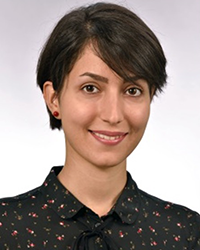
Mina Kheirkhah Rahimabadi, Ph.D.
Read Bio
Mina Kheirkhah Rahimabadi, Ph.D., is a biophysicist studying the classification of brain responses in different patients and in response to different stimuli based on MEG/EEG measurements. Her main areas of interest are using different classification methods, emotions and depression.
She completed her Bachelor of Science in Physics at the University of Isfahan, Iran. She then continued her studies in physics with a Master of Science degree at the Institute for Advanced Studies in Basic Sciences, Iran. Her research focused on complex systems, and various neuron models, which provided a solid background for her to begin her adventure in biophysics. In 2016, she joined Prof. Otto W. Witte's group at Jena University Hospital to learn more about brain measurement methods such as MEG and EEG and to improve her analysis skills, earning her PhD in biophysics. During her doctoral work in the clinic, she worked with facial nerve palsy patients, classifying brain responses to emotional images. She then moved to Prof. Martin Walter's group, CANLAB, and was introduced to several available techniques for treating depression. In 2021, she joined Dr. Carlos Zarate's lab (ETPB) at NIMH as a postdoctoral visiting fellow to study the differences between brain responses of treatment-resistant depression patients compared to healthy controls and those treated with ketamine.
In 2022, Dr. Kheirkhah was awarded from the German Research Foundation (DFG: Deutsche Forschungsgemeinschaft) to collaborate with Dr. Zarate's lab in NIMH and Dr. Martin Walter's lab in Germany to study the effects of music on the treatment of depression.
Education
Ph.D. of Biophysics (University Hospital, Jena, Germany)
Thesis title: Study on classification of emotional expression with MEG & EEG (Part of IRESTRA project)
M.Sc. of physics (IASBS, Zanjan, Iran)
Thesis title: Study on effective factors in theta and gamma rhythm generation in hippocampus
B.Sc. of physics (University of Isfahan, Isfahan, Iran)
Thesis title: Study on predicting sea–level variations in the Caspian Sea with artificial Neural Networks
Selected Publications
- Abnormal Emotional Processing and Emotional Experience in Patients with Peripheral Facial Nerve Paralysis: An MEG Study. Mina Kheirkhah, Stefan Brodoehl, Lutz Leistritz, Theresa Götz, Philipp Baumbach, Ralph Huonker, Otto W. Witte, Gerd Fabian Volk, Orlando Guntinas-Lichius and Carsten M. Klingner.
- The Temporal and Spatial Dynamics of Cortical Emotion Processing in Different Brain Frequencies as Assessed Using the Cluster-Based Permutation Test: An MEG Study. Mina Kheirkhah, Philipp Baumbach, Lutz Leistritz, Stefan Brodoehl, Theresa Götz, Ralph Huonker, Otto W. Witte, Carsten M. Klingner
- Automated emotion classification in the early stages of cortical processing: An MEG study. Mina Kheirkhah*, Stefan Brodoehl, Lutz Leistritz , Philipp Baumbach, Theresa Götz, Ralph Huonker, Otto W. Witte, Carsten M. Klingner.
- The Right Hemisphere Is Responsible for the Greatest Differences in Human Brain Response to High-Arousing Emotional versus Neutral Stimuli: A MEG Study. Mina Kheirkhah*, Philipp Baumbach, Lutz Leistritz , Otto W. Witte, Martin Walter, Jessica R. Gilbert, Carlos A. Zarate Jr, Carsten M. Klingner
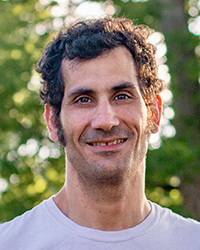
Andrew Persichetti, Ph.D.
Read Bio
Dr. Andrew Persichetti has been working since 2018 as a Postdoctoral Fellow in Dr. Alex Martin’s Section on Cognitive Neuropsychology in the Laboratory of Brain and Cognition at the National Institute of Mental Health (NIMH). Before that, he received his Ph.D. in cognitive neuroscience under the mentorship of Dr. Daniel Dilks at Emory University. Dr. Persichetti’s research focuses on the neural substrates for human conceptual knowledge and utilizes a range of methods with an emphasis on functional MRI (fMRI). As a graduate student, he approached this research goal by studying a model system (i.e., scene perception) to demonstrate that our diverse types of knowledge about the kinds of places we occupy and how to navigate through them are represented by dissociable brain systems with important regions in occipital and temporal cortices.
At the NIMH, he has expanded on this work by zooming out from the scene system to explore a variety of conceptual categories and ask how knowledge representations are supported by multiple large-scale systems, while also zooming in to investigate the differential contribution of cortical layers to imagined actions. His work has been recognized by several awards, including a T32 Predoctoral National Research Service Award from the National Eye institute (NEI) in 2014, a National Science Foundation Graduate Research Fellowship in 2015, and a 2021 NIH Fellows Award for Research Excellence. Most recently, Dr. Persichetti received a K99/R00 Pathway to Independence Award from the NEI to investigate how feedforward and feedback signals related to perception and learning are distributed across layers of human cortex using fMRI. He plans to use this award to continue his research program and make the transition to independent investigator at a research-focused university.
Education
Ph.D., Psychology, Emory University
B.A., Philosophy and Psychology, Portland State University
Selected Publications
- Dilks DD, Kamps FS, & Persichetti AS. (2022). Three cortical scene systems and their development. Trends in cognitive sciences. 26, 117-127.
- Persichetti AS, Denning JM, Gotts SJ, & Martin A. (2021). A data-driven functional mapping of the anterior temporal lobes. Journal of Neuroscience. 41(28), 6038-6049
- Persichetti AS, Avery JA, Huber L, Liu A Merriam EP, & Martin A. (2020). Layer-specific contributions to imagined and executed hand movements in primary motor cortex. Current Biology. 30(9), 1721-1725.
- Persichetti AS, & Dilks DD. (2019). Distinct representations of spatial and categorical relationship across human scene-selective cortex. Proceedings of the National Academy of Sciences. 116(42), 21312-21317.
- Persichetti AS, Butt OH, Aguirre GK, Thompson-Schill SL, & Brainard DH. (2015). fMRI adaptation reveals a non-categorical representation of hue in early visual cortex. Journal of Vision. 15(6):18.
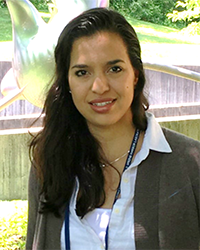
Sofia Beas, Ph.D.
Read Bio
Dr. Sofia Beas is a former Intramural Postdoctoral Fellow in the Unit on Neurobiology of Affective Behaviors at the National Institute of Mental Health (NIMH), under the mentorship of Dr. Mario Penzo. Before joining NIMH, she attained a Ph.D. in Neuroscience from the University of Florida. With the support from a National Science Foundation (NSF) Graduate Research Fellowship, her graduate research focused on further understanding the neural mechanisms of executive functions and decision-making.
During her time at NIMH, Dr. Beas' work focused on investigating the neural mechanisms underlying motivational and affective behaviors following homeostatic challenges (i.e., psychological and metabolic stressors). Specifically, her studies demonstrated the cellular, molecular, and circuit mechanisms by which stressors engage thalamo-striatal projections that are thought to modulate goal-directed behavior. This work resulted in two first-author manuscripts, published in notable scientific journals (Beas et al., 2018, Nature Neuroscience; Beas et al., 2020, Nature Communications) and made her the recipient of several awards, including the prestigious 2020 NIMH Julius Axelrod Memorial Fellowship Training Award for excellence in basic research. Lastly, her work was supported first by a Postdoctoral Research Associate Training PRAT fellowship and then by a K99/R00 BRAIN Initiative Advanced Postdoctoral Career Transition Award to Promote Diversity.
In the summer of 2022, Dr. Beas began a Tenure-Track Faculty position at the University of Alabama at Birmingham (UAB). Dr. Beas' laboratory at UAB continues to pursue the long-term research goals of increasing our understanding of the neural mechanisms underlying motivated behavior and identifying how these processes can be dysregulated in neuropsychiatric disorders.
Education
Ph.D., Neuroscience, University of Florida
B.S., Psychology and Biology, the University of Texas at El Paso
Selected Publications
- Beas, B.S.*# Cummings, K.A*#. A scientific approach to navigating the academic job market (2022). Neuropsychopharmacology. Invited commentary. Feb;47(3):621-627. doi: 10.1038/s41386-021-01225-w. (*Equal contribution, #Corresponding author).
- Ma, J., du Hoffmann, J., Kindel, Morgan., Beas, B.S., Chudasama, Y., Penzo, M.A. Divergent projections of the paraventricular thalamus mediate the selection of reactive and proactive defensive behaviors (2021). Nature Neuroscience. Aug 19. doi: 10.1038/s41593-021-00912-7. Epub ahead of print. PMID: 34413514.
- McQuail, J.A., Beas, B.S., Kelly, K.B., Hernandez, C.M., Bizon, J.L., Frazier, C.J., Attenuated NMDAR signaling on fast-spiking interneurons in prefrontal cortex contributes to age-related decline of cognitive flexibility (2021). Neuropharmacology. Jul 15;197:108720. doi: 10.1016/j.neuropharm.2021.108720. Epub ahead of print. PMID: 34273386.
- Beas, B.S*., Gu, X*., Leng, Y., Koita, O., Rodriguez, S., Kindel, M., Matikainen-Ankney, B.A., Kravitz, A.V., Hoon, M., Penzo, M.A. A ventrolateral medulla-midline thalamic circuit for hypoglycemic feeding (2020). Nature Communications. Dec 4 (11), 6218. doi: 10.1038/s41467-020-19980-7 (*Equal contribution).
- Beas, B.S*., Wright, B.J*., Skirzewski, M., Leng, Y., Hyun, J.H., Koita, O., Ringelberg, N., Buonanno, A., Kwon, H., Penzo, M.A. (2018). The locus coeruleus drives disinhibition in the midline thalamus via dopaminergic mechanisms. Nature Neuroscience. Jul 21(7):963-973. doi: 10.1038/s41593-018-0167-4. (*Equal contribution).
- Beas, B.S., McQuail, J.A., Banuelos, C., Setlow, B., & Bizon, J.L. (2017) Prefrontal cortical GABAergic signaling and impaired behavioral flexibility in aged F344 rats. Neuroscience. Feb 9. pii: S0306-4522(16)00137-8. doi: 10.1016/j.neuroscience.2016.02.014.
- McQuail, JA., Beas, B.S., Kelly, K.B., Simpson, K., Frazier, C.J., Setlow, B., & Bizon, J.L. (2016) NR2A-containing NMDARs in the prefrontal cortex are required for working memory and associated with age-related cognitive decline. The Journal of Neuroscience. Dec 14;36(50):12537-12548. doi: 10.1523/JNEUROSCI.2332-16.2016
- Ianov, L., Rani, A., Beas, B.S., Kumar, A., & Foster, T.C. (2016) Transcriptional profile of aging and cognitive-related genes in the medial prefrontal cortex associated with age-related cognitive decline. Frontiers in Aging Neuroscience. May 17;8:113. doi: 10.3389/fnagi.2016.00113.
- Beas, B.S., Setlow, B., & Bizon, J.L. (2016) Effects of acute administration of the GABA(B) receptor agonist baclofen on behavioral flexibility in rats. Psychopharmacology. Jul;233(14):2787-97. doi: 10.1007/s00213-016-4321-y.
- Beas, B.S., Setlow, B., Samanez-Larkin, G. R., & Bizon, J.L. (2015) Modeling cost-benefit decision making in aged rodents. In Hess, TM, Loeckenhoff, CE, Sttrough (Eds.) Aging and Decision-Making: Empirical and Applied Perspectives, Elsevier Press.
- Banuelos, C., Beas, B.S., McQuail, J.A., Gilbert, R.J., Frazier, C.J., Setlow, B., & Bizon, J.L. (2014) Prefrontal cortical GABAergic dysfunction contributes to age-related working memory impairment. The Journal of Neuroscience. Mar 5;34(10):3457-66. doi: 10.1523/JNEUROSCI.5192-13.2014.
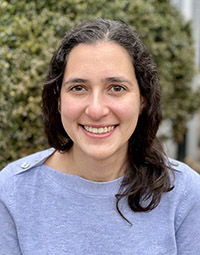
Corinne Beier, Ph.D.
Read Bio
Corinne Beier, Ph.D., is a visual neuroscientist investigating how light information is parsed by the retina and thalamus to drive visual behaviors. She completed her undergraduate training with a degree in Physics from the University of Colorado at Boulder before joining the Electrical Engineering graduate program at the University of California, Santa Cruz in 2011. There she was captivated by a live recording of retinal ganglion cells responding to light flashes in Dr. Alexander Sher’s lab and she never looked back. In her graduate research, Dr. Beier focused on understanding whether circuits in the mammalian retina can correctly rewire after an injury. In 2017 she joined Dr. Samer Hattar’s lab section on Light and Circadian Rhythms at the NIMH to investigate the retinal circuits underlying subconscious light-driven behaviors such as circadian photoentrainment, the pupillary light response, and sleep. More recently she has been studying the retina-to-brain circuits responsible for modulating these behaviors. Dr. Beier is interested in understanding how retinal ganglion cells that are thought to drive conscious vision also influence subconscious visual behaviors.
In 2022, Dr. Beier was awarded a K99/R00 from the National Eye Institute to investigate retina-thalamic circuits. As an independent investigator, Dr. Beier will use the ventral lateral geniculate nucleus as a model to understand why light-influenced behaviors require input from both conscious and subconscious visual pathways.
Education
Ph.D., Electrical Engineering, University of California, Santa Cruz
B.A., Physics, University of Colorado at Boulder
Selected Publications
- Z. Zhang*, C. Beier*, T. Weil, and S. Hattar, “The retinal ipRGC-preoptic circuit mediates the acute effect of light on sleep.” Nature Communications (2021)
- C. Beier, U. Bocchero, Z. Zhang, N. Jin, S. C. Massey, C. P. Ribelayga, K. Martemyanov, S. Hattar, J. Pahlberg, “Retinal circuits driving a non-image forming visual behavior.” bioRxiv (2020)
- C. Beier, Z. Zhang, M. Yurgel, and S. Hattar, “The projections of ipRGCs and conventional RGCs to retinorecipient brain nuclei.” J. of Comparative Neurology (2020)

Courtney Filippi, Ph.D.
Read Bio
Dr. Courtney Filippi is a Postdoctoral Fellow in Dr. Daniel Pine’s laboratory in the Section on Development and Affective Neuroscience at the National Institute of Mental Health (NIMH). She received her Ph.D. in Developmental Psychology at the University of Chicago. During her Ph.D. study under the mentorship of Dr. Amanda Woodward, Dr. Filippi’s graduate research focused on the neural correlates of social behaviors in infancy (e.g., imitation and theory of mind). At the NIMH, her current work involves leading an infant functional magnetic resonance imaging project examining the neural origins of anxiety disorders.
Dr. Filippi has recently received an NIH Pathway to Independence Award (K99/R00) to investigate changes in brain connectivity that are associated with early temperaments that are risk factors for developing social anxiety. This work makes use of the Baby Connectome Project dataset to quantify longitudinal changes in functional connectivity that are associated with behavioral inhibition (a temperament characterized by avoidance of novelty) and self-regulation. Ultimately, Dr. Filippi’s work aims to shape our understanding of brain development and aims to facilitate early identification of risk for anxiety.
In addition to her recent K99 Award, Dr. Filippi was awarded a NARSAD Young Investigator Grant from the Brain and Behavior Research Foundation in 2020.
Education
Ph.D., Developmental Psychology, University of Chicago
B.A., Cognitive Science, University of Virginia
Selected Publications
- Filippi, C.A.*, Valadez, E.A.*, Fox, N.A., Pine, D. (in press). Temperament as a pathway to anxiety: Uncovering the developmental pathophysiology of risk. Current Opinion in Behavioral Sciences.
- Korom, K.*, Camacho, M.C.*, Filippi, C.A., Licandro, R., Moore, L.A., Dufford, A., Zollei, L., Graham, A.M., Spann, M., Howell, B., FIT’NG Group, Shultz, S.*, Scheinost, D*. (in press). Dear Reviewers: Responses to common reviewer critiques about infant neuroimaging studies. Developmental Cognitive Neuroscience.
- Ravi, S.+, Havewala, M., Kircanski, K., Brotman, M., Schneider, L. +, Fox., NA., Pine, D., Leibenluft, E., Filippi, C. (in press). Parenting and childhood irritability: How parents respond to children’s negative emotions moderates the development of irritability. Development and Psychopathology.
- Filippi, C., Subar, A.+, Ravi, S.+, Haas, S., Troller-Renfree, S., Fox, N.A., Leibenluft, E., Pine, D.S. (2021). Developmental changes in the association between cognitive control and anxiety. Child Psychiatry and Human Development.
- Filippi, C., Ravi, S.+, Bracy, M.+, Winkler, A.M., Sylvester, C.M., Pine, D.S., Fox, N.A. (2020). Amygdala functional connectivity and negative reactive temperament at age 4 months. Journal of the American Academy of Child & Adolescent Psychiatry. https://doi.org/10.1016/j.jaac.2020.11.021
- Filippi, C., Sachs, J.F. +, Phillips, D.+, Winkler, A., Gold, A.L., Leibenluft, E., Pine, D.S., Fox, N.A. (2020). Infant behavioral reactivity predicts change in amygdala volume 12 years later. Developmental Cognitive Neuroscience., 42, https://doi.org/10.1016/j.dcn.2020.100776
- Filippi, C., Subar, A.R.+, Sachs, J.+, Kircanski, K., Winker, A., Buzzell, G., Pagliaccio, D., Abend, R., Sylvester, C., Fox, N., Leibenluft, E., Pine, D. (2019). Developmental pathways to social anxiety and irritability: Cognitive control as a moderator. Development and Psychopathology. https://doi.org/10.1017/S0954579419001329

Benjamin Suarez-Jimenez, Ph.D.
Read Bio
Benjamin Suarez-Jimenez, Ph.D. initially joined the NIMH-University College London (UCL) Graduate Partnership Program in 2012 under the mentorship of Drs. Christian Grillon and Daniel S. Pine at the NIMH and Professor Neil Burgess at UCL. His research explored the neural activity involved in building mental maps of our environment as we navigate it. For this purpose, he created and validated novel virtual reality paradigms to study environmental discrimination learning in healthy and anxious adults. His work was recognized by several awards, including the 2016 NIH Scientific Directors Awards for Research Excellence (FARE) and the UCL Institute of Cognitive Neuroscience Best Upgrade to Ph.D. Award. After completing his degree in 2016, he received a T32 Ruth L. Kirschstein Institutional National Research Service Award (NRSA) fellowship to continue his virtual reality and MRI research in posttraumatic stress disorder under the mentorship of Dr. Yuval Neria at Columbia University. Within two years, he was awarded an NIMH K01 grant and two NARSAD young investigator awards and promoted to Assistant Professor in the Psychiatry Department. In 2021, he began a Tenure-Track Assistant Professorship in the Department of Neuroscience at the University of Rochester. His lab continues to explore how we build mental maps of our environment to discriminate between danger, safety, and reward and how this ability is disrupted in psychopathologies of stress and anxiety.
Education
Ph.D., Neuroscience, University College London (jointly with NIMH)
B.A. (Magna Cum Laude), Psychology, University of Puerto Rico, Mayaguez
Selected Publications
- Suarez-Jimenez B, Balderston N, Bisby JA, King JA, Pine DS, Burgess N, Grillon C, Ernst M (2021). Learning about location-dependent threat: neural abnormalities in clinical anxiety. Manuscript submitted for publication at Nature Communication Biology. 31 August 2020, PREPRINT (Version 1) available at Research Square DOI: 10.21203/rs.3.rs-61318/v1
- Suarez-Jimenez B, Albajes-Eizagirre A, Lazarov A, Zhu X, Harrison BJ, Radua J, Neria, Y, Fullana MA (2019). Neural signatures of conditioning, extinction learning, and extinction recall in posttraumatic stress disorder: a meta-analysis of functional magnetic resonance imaging studies. Psychological Medicine, 1-10 DOI: https://doi.org/10.1017/S0033291719001387 .
- Suarez-Jimenez B, Zhu X, Lazarov A, Mann JJ, Schneier F, Gerber A, Barber JP, Chambless DL, Neria Y, Milrod B, Markowitz JC (2019). Anterior Hippocampal Volume Predicts Affect-Focused Psychotherapy Outcome. Psychol Med. 18:1-7. doi:10.1017/S0033291719000187.
- Suarez-Jimenez B, Bisby JA, Horner AJ, King JA, Pine DS, Burgess N (2018). Linked networks for learning and expressing location-specific threat. Proceedings of the National Academy of Sciences (PNAS): 115 (5) E1032-E1040.

Monika Mellem, Ph.D.
Read Bio
Monika Mellem, PhD, is currently a Senior Data Scientist using her neuroscience and engineering training to investigate biomarkers related to psychiatric disorders and their treatment. Since 2016, she has researched the development of multimodal biomarkers for transdiagnostic symptoms as inspired by the NIMH RDoC initiative and investigated personalized medicine approaches using machine learning-based prediction of treatment response while at BlackThorn Therapeutics.
Her training as a NIMH intramural postdoctoral fellow (2013-2016) in the Section on Cognitive Neuropsychology under Dr. Alex Martin included investigations of language and social-emotional interactions in the brain and the intrinsic organization of oscillatory activity across the human cortex. She additionally had the pleasure of serving on the NIMH Fellows Committee supporting several training initiatives. Monika obtained her PhD in neuroscience from Georgetown University in 2013 during which she was awarded a F31 grant. She also holds a MS in electrical engineering from the University of Illinois, Urbana-Champaign (2003). She hopes to continue using her combined skill set to improve healthcare through data science approaches and also eventually to teach data science.
Selected Publications
Mellem, M. S., Kollada, M., Tiller, J., Lauritzen, T. (under review). Explainable AI enables clinical trial patient selection to retrospectively improve treatment effects in schizophrenia. MedRxiv 2021.01.11.20248788, doi: https://doi.org/10.1101/2021.01.11.20248788 .
Mellem, M. S., Liu, Y., Gonzalez, H., Kollada, M., Martin, W. J., Ahammad, P. (2019). Machine learning models identify multimodal measurements highly predictive of transdiagnostic symptom severity for mood, anhedonia, and anxiety. Biol Psychiatry Cogn Neurosci Neuroimaging, 5(1), 56-67.
Mellem, M. S., Wohltjen, S., Ghuman, A., Gotts, S., Martin, A. (2017). Intrinsic frequency profiles and biases across human cortex. J. Neurophysiology, 118(5), 2853-2864.
Mellem, M. S., Jasmin, K., Peng., C., Martin, A. (2016). Sentence processing in the anterior superior temporal lobe shows a social-emotional bias. Neurospychologia, 89, 217-224.
Mellem, M. S., Friedman, R. B., & Medvedev, A. V. (2013). Gamma- and theta-band synchronization during semantic priming reflect local and long-range lexical-semantic networks. Brain and Language, 127(3), 440-451.
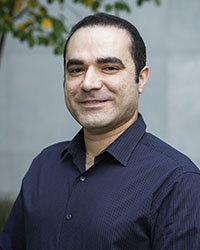
Shahriar SheikhBahaei, Ph.D.
Read Bio
Dr. SheikhBahaei’s interest in neuroscience stemmed from the usual combination of an aptitude for science and a medical problem (stuttering) that brought him into bioscience at a young age. Dr. SheikhBahaei received his bachelor’s degree from the University of California at Berkeley, where he worked with Dr. Bob Zucker on the regulation of neurotransmitter release and Dr. John Rubenstein (UC San Francisco) on development of GABAergic neurons in basal ganglia. Dr. SheikhBahaei completed his doctoral studies in Neuroscience (2017) jointly under NIMH/NINDS – University College London (UCL) Graduate Partnership Program where he worked with Drs. Jeffrey Smith (NINDS) and Alexander Gourine (UCL). His graduate studies were on how astrocytic networks control activities of respiratory motor circuits within the brainstem. After short postdoctoral research at NINDS, Dr. SheikhBahaei became an Independent Research Scholar in 2019. In collaboration with the laboratories of Drs. Chudasama and Leopold at NIMH, Dr. Sheikhbahaei’s lab tries to expand understanding of the anatomical and functional organization of the cortical and subcortical structures controlling volitional and non-volitional vocalizations in social contexts. Dr. SheikhBahaei’s work and contributions to the field have been recognized by several awards, including NINDS Director’s Award for Research Excellence (FARE) in 2015 and 2018, AAAS Joshua E. Neimark Memorial Award, and inaugural selection to the Independent Research Scholar Program of the NIH Office of Intramural Research.
Education
Ph.D., Neuroscience, University College London (jointly with NIMH/NINDS)
BA (Honors), Molecular and Cell Biology, University of California, Berkeley
Selected Publications
- Sheikhbahaei, S., Turovsky, E., Hosford, P, Hadjihambi, A., et al (2018) Astrocytes modulate brainstem respiratory rhythm-generating circuits and determine exercise capacity Nature Communications , 9(1) , 370
- Sheikhbahaei S., Morris, B., Colina, J., Zhang, R., Gourine, A.V., Smith J.C (2018) Morphometric analysis of the brainstem astrocytes Journal of Comparative Neurology , 1–16
- Sheikhbahaei, S. and Smith, J.C (2017)Breathing to inspire and arouse Science , 355(6332) 1370-71
- Sheikhbahaei, S., Gourine, A.V. Smith, J.C. (2017) Respiratory Physiology & Neurobiology Respiratory Physiology & Neurobiology , 246:92-97
- Angelova, P. R., Kasymov, V., Christie, I., Sheikhbahaei, S., Turovsky, E., Marina, N., Gourine, A.V (2015) Functional Oxygen Sensitivity of Astrocytes Journal of Neuroscience , 35(29), 10460–10473
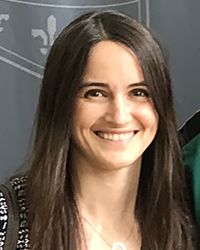
Emily Finn, Ph.D.
Read Bio
Dr. Emily Finn joined the Section on Functional Imaging Methods in 2017 as a postdoctoral fellow with Dr. Peter Bandettini. She uses functional magnetic resonance imaging to study individual differences in brain activity and connectivity and how these relate to behavior. During her postdoc, she has focused on how naturalistic scanning paradigms, such as watching a movie or listening to a story, may be used as a “stress test” for the brain, to draw out targeted idiosyncratic patterns of neural activity in both healthy people and those with or at risk for mental illness. This line of work builds on her graduate thesis, which demonstrated that each individual has a functional connectivity “fingerprint” that is both unique and reliable across various brain states, and that features of these signatures predict high-level cognitive traits such as fluid intelligence. In another line of work at NIMH, she has applied recent developments in high-resolution fMRI to study cortical layer-dependent activity in prefrontal cortex during working memory. In spring 2019, she was awarded a K99/R00 Pathway to Independence grant from the NIMH to support the last phase of her postdoc and her transition to independence. In July 2020, she will begin an assistant professorship in the Department of Psychological and Brain Sciences at Dartmouth College, where her new lab will continue to study individual differences under naturalistic conditions using innovative imaging, behavioral and computational techniques.
Education
PhD, Neuroscience, Yale University
BA, Linguistics, Yale University
Selected Publications
- Finn ES, Huber L, Jangraw DC, Molfese PJ, Bandettini PA. (2019). Layer-dependent activity in human prefrontal cortex during working memory. Nature Neuroscience, 22: 1687-1695
- Finn ES, Corlett PR, Chen G, Bandettini PA, Constable RT. (2018). Trait paranoia shapes inter-subject synchrony in brain activity during an ambiguous social narrative. Nature Communications, 9: 2043.
- Finn ES, Scheinost D, Finn DM, Shen X, Papademetris X, Constable RT. (2017). Can brain state be manipulated to emphasize individual differences in functional connectivity? NeuroImage, 160: 140-151.
- Shen X, Finn ES, Scheinost D, Rosenberg MD, Chun MM, Papademetris X, Constable RT. (2017). Using connectome-based predictive modeling to predict individual behavior from brain connectivity. Nature Protocols 12: 506-18.
- Rosenberg MD*,Finn ES*, Scheinost D, Shen X, Papademetris X, Constable RT, Chun MM. (2016) A neuromarker of sustained attention from whole-brain functional connectivity. Nature Neuroscience, 19: 165–171.
- Finn ES*, Shen X*, Scheinost D, Rosenberg MD, Huang J, Chun MM, Papademetris X, Constable RT. (2015) Functional connectome fingerprinting: Identifying individuals using patterns of brain connectivity. Nature Neuroscience, 18: 1664–1671.

Mark Eldridge , Ph.D.
Read Bio
Dr. Mark Eldridge joined the Section on Neural Coding and Computation at NIMH as a postdoctoral fellow in 2011 under the direction of Dr. Barry Richmond. During his time as a postdoc fellow Dr. Eldridge’s research interests included perception, recognition and categorization of visual stimuli in temporal lobe (2011-2016) and reversible silencing using DREADDs to investigate neural substrates of reward valuation (2016-2019). In December 2018, after completing his post-doctoral fellowship, Dr. Eldridge became a Staff Scientist in the Laboratory of Neuropsychology under the direction of Dr. Betsy Murray (NIMH). His research focuses on understanding how the perceptual and reward value systems interact in the formation of visual memory in non-human primates. He uses traditional techniques (e.g. aspiration lesions & pharmacology), combined with the application of modern molecular tools (e.g. chemogenetics) to explore the neural substrates of recognition, categorization and stimulus value assignment in the inferior temporal lobe and inter-connected regions.
Education
PhD, MRC Centre for Synaptic Plasticity, University of Bristol, UK. Advisors: Profs Malcom Brown & Bob Muller. Project: Neuronal correlates of recognition memory in perirhinal cortex.
Study in industry, Janssen Pharmaceutica, Turnhout, Belgium. Project: Phenotyping of GlyT1 transgenic mouse line, as a putative model for schizophrenia
B.Sc. Pharmacology (with study in industry), University of Bristol, UK
Publications
- Jordi Bonaventura1†, Mark A. G. Eldridge2†, Feng Hu3†, Juan L. Gomez1, Marta Sanchez-Soto4, Ara M. Abramyan5, Sherry Lam1, Matthew Boehm1, Christina Ruiz6, Mitchell Farrell6, Stal S. Shrestha7, Sanjay Telu7, Sami S. Zoghbi7, Robert L. Gladding7, Andrea Moreno8, Islam Mustafa Galal Faress8, Niels Andersen8, John Y. Lin9, Victor W. Pike7, Robert B. Innis7, Ruin Moaddel10, Patrick Morris11, Lei Shi5, David R. Sibley4, Stephen V. Mahler6, Sadegh Nabavi8, Martin G. Pomper3, Antonello Bonci12, Andrew G. Horti3*, Barry J. Richmond2*, Michael Michaelides1, 13* † authors contributed equally. Chemogenetic ligands for translational neurotheranostics. Science (under review)
- Eldridge M.A.G., Matsumoto N., Wittig Jr. J.H., Masseau, E.C., Saunders, R.C., Richmond B.J. Perceptual processing in the ventral visual stream requires area TE but not rhinal cortex. eLife (2018) 7:e36310
- Eldridge M.A.G., Richmond B.J. Resisting the urge to act: DREADDs modifying habits. Trends Neurosci. (2017) Feb;40(2):61-62.
- Yuji Nagai, Erika Kikuchi, Walter Lerchner, Ken-ichi Inoue, Arata Oh-Nishi, Hiroyuki Kaneko, Bin Ji, Yukiko Hori, Yoko Kato, Mark A.G. Eldridge, Katsushi Kumata, Ming-Rong Zhang, Ichio Aoki, Tetsuya Suhara, Masahiko Takada, Makoto Higuchi, Barry J Richmond, Takafumi Minamimoto. PET visualization of chemogenetic receptors used to reversibly alter value-based decision in monkeys. Nat. Comm. (2016) 7: 13605
- Eldridge M.A.G., Lerchner W., Saunders R.C., Kaneko H., Krausz K., Gonzalez F., Ji B., Higuchi M., Minamimoto T., Richmond B.J. Chemogenetic disconnection of monkey orbitofrontal and rhinal cortex reversibly disrupts reward value. Nat. Neurosci. (2016) Jan;19(1):37-9.
- Matsumoto N.*, Eldridge M.A.G.*, Saunders R.C., Reoli R., Richmond B.J., *authors contributed equally. Mild perceptual categorization deficits follow bilateral removal of anterior inferior temporal cortex in rhesus monkeys. J Neurosci. (2016) Jan;36(1):43-53.
- Eldridge M.A.G., Chandra S., Richmond B.J. (2016). Is Visual Processing in Primates Strictly Hierarchical? Advances in Cognitive Neurodynamics (V): Proceedings of the Fifth International Conference on Cognitive Neurodynamics - 2015. R. Wang and X. Pan. Singapore, Springer Singapore: 9-12.

Vay Cao, Ph.D.
Read Bio
I spent just over 5 wonderfully challenging and educational years at the National Institute of Mental Health (NIMH) as a neuroscience doctoral candidate, conducting my thesis dissertation research in a laboratory studying neural activity and behavior. I was fortunate to have joined the NIH Graduate Partnership Program for my PhD, giving me the unique and unforgettable opportunity to do challenging, cutting edge research conducted by a diverse research population within a premiere research institution. As a graduate student who was relatively new to my doctoral field, I was surrounded by others' diverse research studies, with many intellectual extracurricular opportunities available to me.
At the NIMH, I studied how the brain changes in response to motor learning, using in vivo microscopy techniques and marrying my love for behavior with my interest in how our brains work. I also joined the NIH Graduate Student council, serving on the social committee and becoming Co-Chair in my third year. After that, I participated in the student-run acapella group "Nerds in Harmony (NIH)", performing in Building 10 with other researchers and graduate students for patients, visitors and fellow researchers.
As many people will also discover over the course of their research training experience, one important thing I discovered in my PhD was that academic research is not my true calling, even though I will always have the heart of a scientist. I began researching what career options are available to scientists in my third year, taking on opportunities at NIH and beyond to engage in writing, leadership and organizing. After I graduated, I joined a neurotech startup company, moving across the country to start my career in the business world. I feel so fortunate to still be knee deep in my love for neuroscience, but serving the research community in a different way. My first role in industry was as an Application Scientist, and I have since shifted my roles and responsibilities as I continue to grow with my company.
While working my day job, I also founded a career coaching platform and resource center called "Free the PhD," specifically to pay it forward and help fellow PhDs and other graduate students find an easier path into a career they love. Like myself, many will discover that academic research isn't for them, and I am passionate that ushering more talented, ambitious, research-trained individuals into society will make the world a better place. Through my research at the NIMH, I contributed scientific knowledge to my field, and that experience also contributed deeply to making me into the person I am today. Researchers have many avenues through which to disseminate knowledge, discover new things and make an impact, and I'm living proof that you can take your research experience into exciting and rewarding new life directions!
Selected Publications
- Skin suturing and cortical surface viral infusion improves imaging of neuronal ensemble activity with head-mounted miniature microscopes. Li X, Cao VY, Zhang W, Mastwal SS, Liu Q, Otte S, Wang KH. J Neurosci Methods. 2017 Nov 1;291:238-248. doi: 10.1016/j.jneumeth.2017.08.016. Epub 2017 Aug 19. PMID: 28830724 [PubMed - indexed for MEDLINE] Free PMC Article Similar articles
- Multi-layer Cortical Ca2+ Imaging in Freely Moving Mice with Prism Probes and Miniaturized Fluorescence Microscopy. Gulati S, Cao VY, Otte S. J Vis Exp. 2017 Jun 13;(124). doi: 10.3791/55579. PMID: 28654056 [PubMed - indexed for MEDLINE] Free PMC Article Similar articles
- Genetic Feedback Regulation of Frontal Cortical Neuronal Ensembles Through Activity-Dependent Arc Expression and Dopaminergic Input. Mastwal S, Cao V, Wang KH. Front Neural Circuits. 2016 Dec 6;10:100. doi: 10.3389/fncir.2016.00100. eCollection 2016. PMID: 27999532 [PubMed - indexed for MEDLINE] Free PMC Article Similar articles
- Dopamine is Required for Activity-Dependent Amplification of Arc mRNA in Developing Postnatal Frontal Cortex. Ye Y, Mastwal S, Cao VY, Ren M, Liu Q, Zhang W, Elkahloun AG, Wang KH. Cereb Cortex. 2017 Jul 1;27(7):3600-3608. doi: 10.1093/cercor/bhw181. PMID: 27365296 [PubMed - indexed for MEDLINE] Free PMC Article Similar articles
- Motor Learning Consolidates Arc-Expressing Neuronal Ensembles in Secondary Motor Cortex. Cao VY, Ye Y, Mastwal S, Ren M, Coon M, Liu Q, Costa RM, Wang KH. Neuron. 2015 Jun 17;86(6):1385-92. doi: 10.1016/j.neuron.2015.05.022. Epub 2015 Jun 4. PMID: 26051420 [PubMed - indexed for MEDLINE] Free PMC Article Similar articles
- Arc regulates experience-dependent persistent firing patterns in frontal cortex. Ren M, Cao V, Ye Y, Manji HK, Wang KH. J Neurosci. 2014 May 7;34(19):6583-95. doi: 10.1523/JNEUROSCI.0167-14.2014. PMID: 24806683 [PubMed - indexed for MEDLINE] Free PMC Article Similar articles
- In vivo two-photon imaging of experience-dependent molecular changes in cortical neurons. Cao VY, Ye Y, Mastwal SS, Lovinger DM, Costa RM, Wang KH. J Vis Exp. 2013 Jan 5;(71). pii: 50148. doi: 10.3791/50148. PMID: 23329071 [PubMed - indexed for MEDLINE] Free PMC Article Similar articles
- Optogenetic inactivation modifies monkey visuomotor behavior. Cavanaugh J, Monosov IE, McAlonan K, Berman R, Smith MK, Cao V, Wang KH, Boyden ES, Wurtz RH. Neuron. 2012 Dec 6;76(5):901-7. doi: 10.1016/j.neuron.2012.10.016. PMID: 23217739 [PubMed - indexed for MEDLINE] Free PMC Article Similar articles
- Visual avoidance in Xenopus tadpoles is correlated with the maturation of visual responses in the optic tectum. Dong W, Lee RH, Xu H, Yang S, Pratt KG, Cao V, Song YK, Nurmikko A, Aizenman CD. J Neurophysiol. 2009 Feb;101(2):803-15. doi: 10.1152/jn.90848.2008. Epub 2008 Dec 10. PMID: 19073807 [PubMed - indexed for MEDLINE] Free PMC Article Similar articles
- IPRO: an iterative computational protein library redesign and optimization procedure. Saraf MC, Moore GL, Goodey NM, Cao VY, Benkovic SJ, Maranas CD. Biophys J. 2006 Jun 1;90(11):4167-80. Epub 2006 Mar 2. PMID: 16513775 [PubMed - indexed for MEDLINE] Free PMC Article Similar articles

Joel Stoddard, M.D.
Read Bio
Dr. Joel Stoddard is currently an assistant professor with the University of Colorado, School of Medicine and is working towards improved diagnostics and novel therapeutics for severe affective disorders in youth, targeting neurocognitive biases frequently associated with these disorders. Dr. Stoddard is a board-certified psychiatrist who completed clinical neuroscience training at the NIMH intramural program. His training has focused on the application of affective neuroscience techniques to elucidate the pathophysiology of severe affective disorders in children. In particular, chronic irritability is common concern for psychiatrists and is associated with negative outcomes. Dr. Stoddard’s work in irritability has focused on its associated cognitive biases, particularly social threat processing apart from that found in anxiety.
Selected Publications:
- Stoddard J, Hsu D, Reynolds RC, Brotman MA, Ernst M, Pine DS, Leibenluft, E, Dickstein DP. (2014). Aberrant amygdala intrinsic functional connectivity distinguishes youths with bipolar disorder from those with severe mood dysregulation. Psychiatric Research: Neuroimaging. 231(2), 120-125.
- Stoddard J, Sharif-Askary B, Harkins EA, Frank HR, Brotman MA, Penton-Voak IS, Maoz K, Bar-Haim Y, Munafò M, Pine DS, Leibenluft E. (2016). An open pilot study of training hostile interpretation bias to treat disruptive mood dysregulation disorder. Journal of Child and Adolescent Psychopharmacology. 26(1), 49-57.
- Stoddard J, Gotts SJ, Brotman MA, Lever S, Hsu D, Zarate CA, Ernst M, Pine DS, Leibenluft E. (2016). Aberrant intrinsic functional connectivity within and between corticostriatal and temporal-parietal networks in adults and youth with bipolar disorder. Psychological Medicine. 46(7), 1509-22.
- Jarcho J, Davis MM, Shechner T, Degnan KA, Henderson HA, Stoddard J, Fox NA, Leibenluft E, Pine DS, Nelson EE. (2016). Early childhood social reticence predicts brain function in preadolescent youths during distinct forms of peer evaluation. Psychological Science. 27(6), 821-835.
- Maoz K, Eldar S, Stoddard J, Pine DS, Leibenluft E, Bar-Haim Y. (2016). Angry-happy interpretations of ambiguous faces in social anxiety disorder. Psychiatry Research. 241, 122-127.
- Tseng WL, Thomas LA, Harkins E, Stoddard J, Zarate CA, Pine DS, Leibenluft E, Brotman MA. (2016). Functional connectivity during masked and unmasked face emotion processing in bipolar disorder. Psychiatry Research: Neuroimaging. 258, 1-9.
- Tseng WL, Moroney E, Machlin L, Roberson-Nay R, Hettema JM, Carney D, Stoddard J, Towbin KA, Pine DS, Leibenluft E, Brotman MA. (2017). Test-retest reliability of a frustration paradigm and irritability measures. Journal of Affective Disorders. 212, 38-45.
- Stoddard J, Tseng WL, Kim P, Yi J, Donahue L, Brotman MA, Towbin KA, Pine DS, Leibenluft E. (2017). Association of irritability and anxiety with the neural mechanisms of implicit face-emotion processing in youths with psychopathology. JAMA: Psychiatry. 74(1), 95-103.
- Weisman O, Guri Y, Gur RE, McDonald-McGinn DM, Calkins ME, Tang SX, Emanuel B, Zackai EH, Eliez S, Schneider M, Schaer M, Kates WR, Antshel KM, Fremont W, Shashi V, Hooper SR, Armando M, Pontillo M, Kushan L, Jalbrzikowski M, Bearden CE, Cubells JF, Ousley OY, Walker EF, Simon TJ, Stoddard J, Niendam TA, van den Bree MBM, Gothelf D, International Consortium on Brain and Behavior in 22q11.2 Deletion Syndrome. (2017). Subthreshold Psychosis in 22q11.2 Deletion Syndrome: Multisite Naturalistic Study. Schizophrenia Bulletin. 43(5) 1079-1089.
- Chen G, Taylor PA, Haller SP, Kircanski K, Stoddard J, Pine DS, Leibenluft E, Brotman MA, Cox RW. (2017) Intraclass correlation: improved modeling approaches and applications for neuroimaging. bioRxiv. 164327

Wan-Ling Tseng, Ph.D.
Read Bio
Dr. Wan-Ling Tseng is a Postdoctoral Fellow in Dr. Ellen Leibenluft’s laboratory in the Section on Mood Dysregulation and Neuroscience at the National Institute of Mental Health (NIMH). She received her PhD in Developmental Psychology from the Institute of Child Development at the University of Minnesota. During her PhD study under the mentorship of Dr. Nicki R. Crick, Dr. Tseng’s graduate research focused on the developmental trajectories of aggression and attention-deficit hyperactivity disorder (ADHD) and associated social impairment. In Dr. Ellen Leibenluft’s laboratory at the NIMH, her current work focuses on understanding the brain mechanisms mediating abnormal psychological processes associated with irritability in children and adolescents.
Dr. Tseng has recently received an NIH Pathway to Independence Award (K99) to use machine learning, a data-driven computational approach, to investigate the neural mechanisms of childhood irritability. Her goal is to understand individual differences in how children process frustrating events, how frustration affects the neural mechanisms underlying attention and other cognitive function, and how these processes are associated with real-life irritability. Ultimately, her research goal is to study irritability using multiple levels of analysis (e.g., brain, behavior, environment) to gain a comprehensive understanding of the etiology and development of irritability.
In addition to her recent K99 Award, Dr. Tseng’s work has been recognized by other prestigious awards and organizations including the Society of Biological Psychiatry Travel Award (2015), Career Development Institute for Bipolar Disorder (2015), NIH Fellows Award for Research Excellence (2015), and the NIMH OFT Trainee Travel Award (2016).
Selected Publications
- Tseng, W. L., Moroney, E., Machlin, L., Roberson-Nay, R., Hettema, J. M., Carney, D., Stoddard, J., Towbin, K. A., Pine, D. S., Leibenluft, E., & Brotman, M. A. (2017). Test-retest reliability and validity of a frustration paradigm and irritability measures. Journal of Affective Disorders, 212, 38-45.
- Stoddard, J., Tseng, W. L., Kim, P., Chen, G., Yi, J., Donahue, L., Brotman, M. A., Towbin, K. A., Pine, D. S., & Leibenluft, E. (2017). Association of irritability and anxiety with the neural mechanisms of implicit face emotion processing in youths with psychopathology. JAMA Psychiatry, 74, 95-103.
- Tseng, W. L., Thomas, L. A., Harkins, E., Stoddard, J., Zarate, C. A., Pine, D. S., Leibenluft, E., & Brotman, M. A. (2016). Functional connectivity during masked and unmasked face emotion processing in bipolar disorder. Psychiatry Research: Neuroimaging, 258, 1-9.
- Tseng, W. L., Thomas, L. A., Harkins, E., Pine, D. S., Leibenluft, E., & Brotman, M. A. (2016). Neural correlates of masked and unmasked face emotion processing in severe mood dysregulation. Social Cognitive Affective Neuroscience, 11, 78-88.
- Tseng, W. L., Guyer, A. E., Briggs-Gowan, M. J., Axelson, D., Birmaher, B., Egger, H. L., Helm, J., Stowe, Z., Towbin, K. A., Wakschlag, L. S., Leibenluft, E., & Brotman, M. A. (2015). Behavior and emotion modulation deficits in preschoolers at risk for bipolar disorder. Depression and Anxiety, 32, 325-334.
- Tseng, W. L., Bones, B. L., Kayser, R. R., Olsavsky, A. K., Fromm, S. J., Pine, D. S., Leibenluft, E., & Brotman, M. A. (2015). An fMRI study of emotional face encoding in youth at risk for bipolar disorder. European Psychiatry, 30, 94-98.
- Tseng, W. L., Kawabata, Y., Gau, S. S., & Crick, N. R. (2014). Symptoms of attention-deficit/hyperactivity disorder and peer functioning: A transactional model of development. Journal of Abnormal Child Psychology, 42, 1353-1365.
- Brotman, M. A., Tseng, W. L., Olsavsky, A. K., Fromm, S. J., Muhrer, E. J., Rutenberg, J. G., Deveney, C. M., Adleman, N. E., Zarate, C. A., Pine, D. S., & Leibenluft, E. (2014). Fronto-limbic-striatal dysfunction in pediatric and adult patients with bipolar disorder: Impact of face emotion and attentional demands. Psychological Medicine, 44, 1639-1651.
- Tseng, W. L., & Gau, S. S. (2013). Executive function as a mediator for the link between attention-deficit/hyperactivity disorder and social problems. Journal of Child Psychology and Psychiatry, 54, 996-1004.
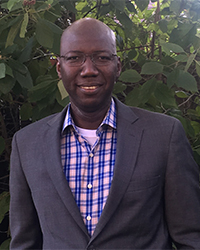
Mbemba Jabbi, Ph.D.
Read Bio
Dr. Mbemba Jabbi is an Assistant Professor at the Department of Psychiatry, Dell Medical School at the University of Texas at Austin. His lab studies how genes influence the structural and functional properties of brain circuitries critical for perception, cognition and adaptive aspects of human emotions. To better understand the neurogenetic influences on emotions, his group examines how the emergence of affective disorders are linked to genetic signatures of maladaptive brain functions. His research is integrative in that he: 1) analyzes normal behavioral, diagnostic and environmental phenotypes of affective states, 2) applies anatomical and physiological neuroimaging measures to analyze emotionally tractable brain states, and 3) employs genetic and molecular analyses of adaptive and maladaptive brain-mediated affective functions across the human developmental spectrum.
Education
After obtaining his Ph.D. in Clinical Neuroscience from the University of Groningen, he joined Dr. Karen Berman’s Section of Integrative Neuroimaging in 2007 as a Fogarty International Visiting Postdoctoral Fellowship. Mbemba continued training with Dr. Berman as a research fellow until he joined the Dell Medical School’s Department of Psychiatry, at the University of Texas, Austin in 2016.
NIMH Publications
- Variation in the Williams syndrome GTF2I gene and anxiety proneness interactively affect prefrontal cortical response to aversive stimuli. Jabbi M, Chen Q, Turner N, Kohn P, White M, Kippenhan JS, Dickinson D, Kolachana B, Mattay V, Weinberger DR, Berman KF. Transl Psychiatry. 2015 Aug 18;5:e622. doi: 10.1038/tp.2015.98. PMID: 26285132 [PubMed - indexed for MEDLINE] Free PMC Article
- The Williams syndrome chromosome 7q11.23 hemideletion confers hypersocial, anxious personality coupled with altered insula structure and function. Jabbi M, Kippenhan JS, Kohn P, Marenco S, Mervis CB, Morris CA, Meyer-Lindenberg A, Berman KF. Proc Natl Acad Sci U S A. 2012 Apr 3;109(14):E860-6. doi: 10.1073/pnas.1114774109. Epub 2012 Mar 12. PMID: 22411788 [PubMed - indexed for MEDLINE] Free PMC Article
- Bridging the gene-behavior divide through neuroimaging deletion syndromes: Velocardiofacial (22q11.2 Deletion) and Williams (7q11.23 Deletion) syndromes. Eisenberg DP, Jabbi M, Berman KF. Neuroimage. 2010 Nov 15;53(3):857-69. doi: 10.1016/j.neuroimage.2010.02.070. Epub 2010 Mar 3. Review. PMID: 20206275 [PubMed - indexed for MEDLINE] Free PMC Article
- BDNF Val66 Met polymorphism tunes frontolimbic circuitry during affective contextual learning. Jabbi M, Cropp B, Nash T, Kohn P, Kippenhan JS, Masdeu JC, Mattay R, Kolachana B, Berman KF. Neuroimage. 2017 Sep 1;162:373-383. doi: 10.1016/j.neuroimage.2017.08.080. [Epub ahead of print] PMID: 28867340 [PubMed - as supplied by publisher]
- Midbrain presynaptic dopamine tone predicts sustained and transient neural response to emotional salience in humans: fMRI, MEG and FDOPA PET. Jabbi M, Nash T, Kohn P, Ianni A, Rubinstein D, Holroyd T, Carver FW, Masdeu JC, Kippenhan JS, Robinson SE, Coppola R, Berman KF. Mol Psychiatry. 2013 Jan;18(1):4-6. doi: 10.1038/mp.2012.12. Epub 2012 Mar 13. No abstract available. PMID: 22411228 [PubMed - indexed for MEDLINE] Free PMC Article
- Convergent BOLD and Beta-Band Activity in Superior Temporal Sulcus and Frontolimbic Circuitry Underpins Human Emotion Cognition. Jabbi M, Kohn PD, Nash T, Ianni A, Coutlee C, Holroyd T, Carver FW, Chen Q, Cropp B, Kippenhan JS, Robinson SE, Coppola R, Berman KF. Cereb Cortex. 2015 Jul;25(7):1878-88. doi: 10.1093/cercor/bht427. Epub 2014 Jan 23. PMID: 24464944 [PubMed - indexed for MEDLINE] Free PMC Article

Harma Meffert, Ph.D.
Read Bio
Dr. Harma Meffert joined Dr. James R. Blair’s team as a Postdoctoral Fellow in 2012 (Section on Affective and Cognitive Neuroscience). She earned an M.S. in Cognitive Psychology (University of Groningen) and a Ph.D. in Cognitive and Affective Neuroscience (University Medical Center Groningen). During her Ph.D., Dr. Meffert showed that forensic patients with psychopathy display reduced activation in regions previously related to empathy, while observing emotional hand interactions. The data also showed that the empathy deficit might not be as static as previously thought; brain responses normalized with respect to typically developing adults when asked to actively empathize with the interactions. At the NIMH, Dr. Meffert focused on form and function of empathy deficits in youth with disruptive behavior disorders and limited prosocial emotions. Her main aim was to understand how emotional empathy fosters learning from other peoples’ experiences. To this end, Dr. Meffert developed a social referencing task during which participants learn about object valence by observing others’ emotional responses to these objects. This showed that the amygdala processes expression prediction errors during acquisition and is associated with responses to objects after acquisition. Dr. Meffert has been chair of the NIMH Fellows Committee from 2012 to 2015 and a research mentor in the NIMH Summer Internship Program in Biomedical Research. In 2015, Dr. Meffert became Director of the Social Cognition Research Program at Boys Town National Research Hospital (BTNRH). Boys Town offers services to children such as in-home family services and the Family Home ProgramSM (treatment foster-care program serving +400 youth annually). In 2015, BTNRH established the Center for Neurobehavioral Research, where she was the first PI to join. Here, Dr. Meffert works on further characterizing empathy deficits in disruptive youth with limited prosocial emotions and varying levels of prior trauma. In particular, her goal has been to understand how you with disruptive behavior respond to others’ distress as a function of prior trauma.
Education
Ph.D. in Cognitive and Affective Neuroscience. University Medical Center Groningen and Forensic Psychiatric Clinic Dr. S. van Mesdag. Thesis: ‘Empathy under arrest?’ Promotores: Dr. Christian Keysers and Dr. Johan A. den Boer. Defense 2012.
M.S. in Cognitive Psychology, University of Groningen, Department of Experimental and Work Psychology. Thesis: ‘Effects of Mental Fatigue on Memory Performance’. Grade: 9 (out of 10). Supervisor: Dr. Monicque M. Lorist. 1999 – 2004.
Propaedeutic exam: Chemical Technology, University of Twente. 1995 – 1998.
NIMH publications
- Meffert, H., Brislin, S. J., White, S. F., & Blair, J. R. (2014). Prediction errors to emotional expressions: The roles of the amygdala in social referencing. Social Cognitive and Affective Neuroscience.
- Meffert, H., Blanken, L., Blair, K. S., White, S. F., & Blair, J. R. (2013). The influence of valence and decision difficulty on self-referential processing. Frontiers in Human Neuroscience, 7, 46. http://doi.org/10.3389/fnhum.2013.00046
- Meffert, H., Hwang, S., Nolan, Z. T., Chen, G., & Blair, J. R. (2016). Segregating attention from response control when performing a motor inhibition task: Segregating attention from response control. NeuroImage, 126, 27–38.
- Meffert, H., Hwang, S., Nolan, Z. T., Chen, G., & Blair, J. R. (2016). BOLD data representing activation and connectivity for rare no-go versus frequent go cues. Data in Brief. https://doi-org /10.1016/j.dib.2016.02.011
- Blair, R. J. R., White, S. F., Meffert, H., & Hwang, S. (2013). Emotional learning and the development of differential moralities: implications from research on psychopathy. Annals Of The New York Academy Of Sciences, 1299(1), 36–41. https://doi.org/10.1111/nyas.12169
- White, S. F., Brislin, S. J., Meffert, H., Sinclair, S., & Blair, R. J. R. (2013). Callous-unemotional traits modulate the neural response associated with punishing another individual during social exchange: A preliminary investigation. Journal of Personality Disorders, 27(SPL.ISS.1), 99–112. White, S. F., Clanton, R., Brislin, S. J., Meffert, H., Hwang, S., Sinclair, S., & Blair, R. J. (2014). Reward: empirical contribution. Temporal discounting and conduct disorder in adolescents. Journal of Personality Disorders, 28(1), 5–18. https://doi.org/10.1521/pedi.2014.28.1.
- White, S. F., Geraci, M., Lewis, E., Leshin, J., Teng, C., Averbeck, B., Meffert, H.,… Blair, K. S. (2016). Prediction Error Representation in Individuals With Generalized Anxiety Disorder During Passive Avoidance. The American Journal of Psychiatry, appiajp201615111410.

Soonjo Hwang, M.D.
Read Bio
Dr. Soonjo Hwang, M.D., joined NIMH in July, 2012 as a clinical fellow working under the supervision of Principal Investigator, Dr. James Bair in the Section on Affective Cognitive Neuroscience (SACN). The SACN’s focus of research was the neurobiological understanding of behavioral/emotional disorders in the pediatric population, especially regarding conduct disorder, oppositional defiant disorder, and ADHD.
In 2015, Dr. Hwang accepted a position with the University of Nebraska, Medical Center (UNMC) as an assistant professor where he expanded his research to clinical trials. By combining clinical trials with neuroscientific modalities, including neuroimaging (fMRI and magnetoencephalography), and genetic testing Dr. Hwang hopes to gain a comprehensive understanding of neurocircuitry dysfunction and their response to different interventions. Dr. Hwang is also conducting large-scale data collection on symptom profiles and behavioral data of various neuropsychological tasks for pediatric populations with disruptive mood and behavioral disorders.
Dr. Hwang is currently conducting two clinical trials in children and adolescents with disruptive mood and behavior disorders. One of these trials is a collaboration with Boys Town National Research Hospital, Neurobehavioral Research Center where his former supervisor and mentor, Dr. James Blair now serves as Director. The other clinical trial is an international collaboration project with the Ministry of Education and School of Mental Health Research and Resources Center in South Korea.
Education
Clinical Fellowship - Section on Affective Cognitive Neuroscience, NIMH, Bethesda, MD
Residency – General Psychiatry at Westchester Medical Center/New York Medical College, NY; Child and Adolescent Psychiatry at Massachusetts General Hospital/McLean Hospital/Harvard Medical School in Boston, MA
Internship - General Psychiatry at Severance Hospital/Yonsei University, College of Medicine in Seoul, South Korea
M.D - Yonsei University College of Medicine in Seoul, South Korea
M.B - Yonsei University College of Medicine in Seoul, South Korea
Awards (at NIH)
2014 Grant recipient, The Ministry of Education of Republic of Korea.
2013 Training awardee, Fondazione Child. Dr. Hwang attended the “10th International Training Seminar for Junior Investigators in Child and Adolescent Psychiatry” in Bocca di Magra (La Spezia), Italy.
NIMH publications
- Soonjo Hwang; Stuart White, Zachary Nolan, Craig Williams, Stephen Sinclair, and James Blair. Dual Neuro-circuitry Dysfunctions in Disruptive Behavior Disorders: Emotional Responding and Response Inhibition. Psychological Medicine Vol 46 (7) pp1485-1496. May, 2016.
- Soonjo Hwang; Stuart White, Zachary Nolan, Stephen Sinclair, and James Blair. Executive attention control and emotional responding in attention-deficit/hyperactivity disorder - A functional MRI study. Neuroimage: Clinical. Vol 9 pp545-554. October 2015.

Michelle Y. Cortes, Ph.D.
Read Bio
Dr. Michelle Y. Cortes joined the PET Radiopharmaceutical Science Laboratory, Molecular Imaging Branch (MIB) of NIMH as an IRTA Postdoctoral fellow in October 2013, under the supervision of Dr. Victor W. Pike. She earned a B.S. and an M.S. in Chemistry from the University of Puerto Rico. Dr. Cortes holds a Ph.D. in Organic Chemistry from the University of South Florida with a research emphasis on the development and evaluation of sigma receptor ligands used as potential post-ischemic stroke therapeutics. Dr. Cortes interest in the detection and progression of neuroinflammatory diseases led her to join the PET Radiopharmaceutical Science Section where her current research involves the development of novel COX-1 and COX-2 imaging agents used for the detection of neuroinflammatory diseases and neuropsychiatric disorders using Positron Emission Tomography (PET). Dr. Cortes has showcased her research presenting her work in various international and national conferences. Recently, she was awarded the Best Poster Award at the American Chemical Society (ACS), National Organic Symposium (NOS). In addition to her research work, Dr. Cortes served as a research mentor in the NIMH Summer Internship Program in Biomedical Research (SIP) in her efforts to promote higher education in the biomedical fields. Dr. Cortes was selected as one of 30 professionals to participate at the Linton-Poodry Society for Advancement of Chicanos/Hispanics and Native Americans in Science (SACNAS) Leadership Institute where members from government, industry, and academia gathered at the American Association for the Advancement of Science (AAAS) headquarters in Washington, DC, Institute to discuss how to promote higher education in the STEM fields in their communities. Dr. Cortes is currently the NIH-SACNAS Chapter president leading the chapter’s planning and execution of the activities to promote professional development, leadership, and wellness, and promotes efforts for dissemination of information and outreach in the DC, MD, and VA areas. Dr. Cortes is leading efforts to promote collaborations within NIH community as well as will other non-profit associations that share SACNAS mission. Under her leadership, the NIH SACNAS Chapter received the recognition of the 2016 SACNAS Professional Chapter of the Year Award at the SACNAS National Conference.
Education
NIMH IRTA Postdoctoral Fellow, PET Radiopharmaceutical Science Laboratory, NIMH, Bethesda, MD
Ph.D. in Organic Chemistry, University of South Florida, Tampa, Florida Center of Excellence-Biomolecular Identification of Target Therapeutics Fellowship (FCoe-BITT)
M.S. in Chemistry, University of Puerto Rico-Mayagüez, Puerto Rico
B.S. in Chemistry, University of Puerto Rico-Mayagüez, Puerto Rico
Awards (at NIH)
2016 SACNAS Professional Chapter of the Year-SACNAS National
2016 Linton-Poodry SACNAS Leadership Institute
2015 Best Poster Award- 44th National Organic Symposium
NIMH abstracts of publications
- Cortes, M.; Singh, P.; Morse, C.; Kowalsky, A.; Shrestha, S.; Jenko, K.; Zoghbi, S.; Fujita, M.; Innis, R.; Pike, V. W. Synthesis of PET radioligands as potential probes for imaging COX-2 in neuroinflammation. J. Nucl. Med. 2015, S3, 1092.
- Singh, P.; Cortes, M.; Morse, C.; Jenko K.; Shrestha, S.; Zoghbi, S.; Gladding, R. Fujita, M.; Innis, R.; Pike V.W. [18F]PS-2 as candidate radioligand for imaging COX-1 expression in brain: radiosynthesis and monkey PET imaging. J. Nucl. Med. 2015, S3, 1091.
- Cortes, M.; Singh, P.; Morse, C.; Kowalsky, A.; Shrestha, S.; Jenko, K.; Zoghbi, S.; Fujita, M.; Innis, R.; Pike, V.W. Synthesis of a candidate brain-penetrant COX-2 PET radioligand as a potential probe for neuroinflammation. J. Label Compd. Radiopharm. 2015, 58, S312.
- Singh, P.; Cortes, M.; Morse, C.; Jenko, K.; Shrestha, S.; Gladding, R.; Fujita, M.; Innis, R. B.; Pike, V. W.; Radiosynthesis and evaluation of [11C]FK881 as a PET radioligand for imaging brain COX-1 in monkey. J. Label Compd. Radiopham. 2015, 58, S055.
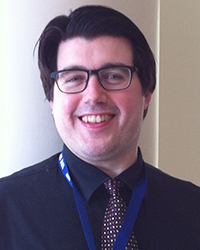
Mark J. Niciu, M.D., Ph.D.
Read Bio
Mark J. Niciu, M.D., Ph.D. joined the Experimental Therapeutics and Pathophysiology Branch of the NIMH in July 2012, under the supervision of Carlos A. Zarate Jr. M.D. as a clinical fellow. He completed his adult psychiatry residency in the Neuroscience Research Training Program (NRTP) at Yale University and, during his 4th year, was the program-wide chief resident and chief resident on the Clinical Neuroscience Research Unit. Mark is the lead associate investigator on the following research protocol: “The Neurophysiological Effects of Intravenous Alcohol as Potential Biomarkers of Ketamine’s Rapid Antidepressant Effects in Major Depressive Disorder” (ClinicalTrials.gov identifier: NCT02122562). This protocol served as the research plan for Dr. Niciu’s K99R00 “Pathway to Independence” career development award application, which he received and commenced in January 2016. Dr. Niciu has also received a Brain and Behavior Research Foundation/NARSAD Young Investigator award for his collaborative stem cell work with the Laboratory of Neurogenetics in the National Institute of Alcoholism and Alcohol Abuse (NIAAA).
Education
Fellowship – Experimental Therapeutics and Pathophysiology Branch (ETPB), NIMH, Bethesda, MD
Residency – Yale University Department of Psychiatry, Neuroscience Research Training Program, New Haven, CT
Medical/Graduate Schools (Medical Scientist Training Program) – University of Connecticut School of Medicine, Farmington, CT
College – Manhattan College, Riverdale, NY
NIMH Publications (3 representatives selected)
- Niciu MJ, Luckenbaugh DA, Ionescu DF, Richards EM, Vande Voort JL, Ballard ED, Brutsche NE, Furey ML, Zarate CA Jr (2014) Ketamine’s antidepressant efficacy is extended for at least four weeks in subjects with a family history of an alcohol use disorder. Int J Neuropsychopharmacol 18(1); http://www.ncbi.nlm.nih.gov/pubmed/25539512
- Niciu MJ, Luckenbaugh DA, Ionescu DF, Guevara S, Machado-Vieira R, Richards EM, Brutsche NE, Nolan NM, Zarate CA Jr (2014) Clinical predictors of ketamine response in treatment-resistant major depression. J Clin Psychiatry75(5):e417-23; http://www.ncbi.nlm.nih.gov/pubmed/24922494
- Niciu MJ, Henter ID, Luckenbaugh DA, Zarate CA Jr, Charney DS (2014) Glutamate receptor antagonists as fast-acting therapeutic alternatives for the treatment of depression: ketamine and other compounds. Annu Rev Pharmacol Toxicol 54:119-39; http://www.ncbi.nlm.nih.gov/pubmed/24392693

Gioia M. Guerrieri, DO, FAPA
Read Bio
Gioia M. Guerrieri, DO, FAPA, joined the Behavioral Endocrinology Branch of the NIMH in September, 2011, under the supervision of Peter J. Schmidt, MD. She transferred from the Mayo Clinic to the NIMH as an intramural Clinical Research Fellow combined with an ACGME accredited 4th year residency (one of two residents selected for graduating class). She then stayed on to complete her research fellowship. From 2011-2015, Gioia served as an associate investigator on clinical trials in Reproductive Endocrine-Related Mood Disorders (postpartum depression, perimenopause-onset depression, and premenstrual dysphoric disorder). Her research was focused on 1) mood events surrounding the menopause (normally timed and premature menopause), 2) hormone triggers that elicit stress responsivity in some women and not others, and 3) characteristics of the endocrine trigger in postpartum depression. Gioia gained tremendous skills and expertise at NIMH that serve her well at the Food and Drug Administration (FDA) and with her private practice. In September, 2015, Gioia joined the Center for Drug Evaluation and Research, Office of New Drugs, FDA. She provides regulatory medicine expertise as a medical officer and clinical reviewer with the Division of Psychiatry Products. As part of her professional development program, she continues to work with Peter Schmidt in the Behavioral Endocrinology Branch of the NIMH.
Education
Fellowship – Behavioral Endocrinology, NIMH, Bethesda, MD
Residency – Mayo Clinic, School of Graduate Medical Education, Department of Psychiatry and Psychology, Rochester, MN; Behavioral Endocrinology, NIMH,Bethesda, MD
Internship – Mayo Clinic, School of Graduate Medical Education, Department of Psychiatry and Psychology, Rochester, MN
Medical School – University of New England College of Osteopathic Medicine, Biddeford, ME
NIMH patient education on postpartum depression: https://www.youtube.com/watch?v=O-A7YvrjFL8
NIMH publications
- Guerrieri GM, Wakim PG, Keenan PA, Schenkel LA, Berlin K, Gibson CJ, Rubinow DR, Schmidt PJ. Sex differences in visuospatial abilities persist during induced hypogonadism. Neuropsychologia. 81 (2016) 219-229 http://www.ncbi.nlm.nih.gov/pubmed/26719236
- Schmidt PJ, Ben Dor R, Martinez PE, Guerrieri GM, Harsh VL, Thompson K, Koziol DE, Nieman LK, Rubinow DR. Effects of Estradiol Withdrawal on Mood in Women with Past Perimenopausal Depression. JAMA Psychiatry. June, 2015 http://www.ncbi.nlm.nih.gov/pubmed/26018333
- Guerrieri GM, Martinez PE, Klug SP, Haq NA, Vanderhoof VH, Koziol K, Popat V, Rubinow DR, Schmidt PJ, Nelson LM. Effects of Physiologic Testosterone Replacement on Quality of Life, Mood, and Self-Esteem in Women with Spontaneous 46, XX Primary Ovarian Insufficiency. Menopause. Vol 21.9 September, 2014 http://www.ncbi.nlm.nih.gov/pubmed/24473536

Talakad Goolaiah Lohith, MBBS, MMST, Ph.D.
Read Bio
Assoc. Prin. Scientist, Imaging
Translational Biomarkers
Merck Research Laboratories
Research Highlight
Dr. Talakad Lohith joined the Molecular Imaging Branch of NIMH in July 2009 as a post-doctoral visiting fellow under the supervision of Robert B. Innis, who leads development and evaluation of positron emission tomography (PET) ligands for neuroimaging. Dr. Lohith led multiple clinical and preclinical PET neuroimaging projects using novel PET tracers for neuroinflammation and mood disorders. He evaluated preclinical and clinical first-in-human trial of a new opioid receptor target called nociceptin orphanin peptide (NOP) receptor using a novel PET radioligand 11C-NOP-1A. NOP receptors were imaged for the first time in healthy human brain and quantified by kinetic modeling of PET scans. New PET ligands were characterized for imaging and quantification of translocator (TSPO) protein, 5-HT4 receptor and P-gp efflux transporter in vivo in monkey & rodent brain. Dr. Lohith gained immense skills and expertise at NIMH to facilitate new PET molecular imaging tracers for clinical application.
In January 2015, Dr. Lohith became an Associate Principal Scientist in the Imaging Department at Merck & Co., Inc. He provides image analysis expertise as a PET Kinetic Modeler. Dr. Lohith current research focus is to facilitate clinical translation of new drug candidates in Merck therapeutic pipeline using PET imaging for proof-of-concept and proof-of mechanism studies in clinical trials.
Education
Ph.D. in Imaging Sciences, University of Fukui, Fukui, Japan, 2009
MMST in Biomedical Engineering, Indian Institute of Technology, Kaharagpur, India, 2004
MBBS in Medicine, Bangalore University, Bangalore, India, 2000
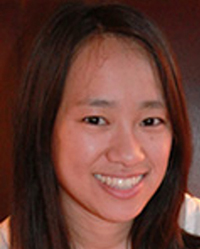
Haochang Shou, Ph.D.
Read Bio
Haochang Shou joined the Genetic Epidemiology Research Branch at NIMH in 2013 as a Pre-Doctoral Visiting Fellow. Under the supervision of Dr. Kathleen Merikangas, she focused on analyzing the accelerometry data from the NIMH Family Study of Affective Spectrum Disorders. There she had the chance to apply her statistical expertise to the novel phenotypical measures collected by wearable computing sensors. She proposed comprehensive statistical modeling approach such as functional data analysis to evaluate the associations between physical activity and mood disorders while acknowledging the high-resolution and real-time data features. Her valuable experience at NIMH has also equipped her with adequate clinical knowledge in mental health.
Haochang is now an Assistant Professor in Biostatistics at University of Pennsylvania Perelman School of Medicine. In addition to her methodological research on multilevel functional and longitudinal data with complex structures, she has been expanding her collaborations in physical activity under various medical conditions. She has also been continuing collaborating with Dr. Merikangas’s research group and plans to integrate multimodal measurements from genetics, neuroimaging and activity in psychiatric settings to obtain better understanding of psychological pathophysiology.
Education
Undergraduate: B.Sc. in Statistics, Peking University, Beijing, China
Graduate: Ph.D. in Biostatistics, Johns Hopkins Bloomberg School of Public Health, Baltimore, MD.

Nancy Lee, Ph.D.
Read Bio
Nancy Raitano Lee is a child clinical psychologist who completed her post-doctoral training in Jay Giedd’s Section on Brain Imaging within the Child Psychiatry Branch of the NIMH. Her research focuses on the cognitive and neuroanatomic correlates of developmental learning disorders. Much of her work has focused on the neuropsychology and neuroanatomy of Down syndrome and sex chromosome aneuploidies. She has also completed research on the neuroanatomic correlates of individual differences in cognitive abilities, such as vocabulary knowledge and executive functioning.
Nancy joined the Psychology department at Drexel University in September as an Assistant Professor. In addition to teaching classes on typical and atypical child development and neuropsychology, she will continue to conduct studies on language, executive, and academic functioning in youth with Down syndrome and other developmental learning disorders. Moreover, she plans to continue collaborating with colleagues in the intramural research program of the NIMH on the neuroanatomy and neurophysiology of Down syndrome and other chromosomal disorders.
Education
Undergraduate: B.S. with Honors & Distinction in Human Development & Family Studies, Cornell University, Ithaca, NY
Graduate: MA & PhD: Child Clinical Psychology with Specialization in Developmental Cognitive Neuroscience, University of Denver, Denver, CO

Peter Rudebeck, Ph.D.
Read Bio
Peter Rudebeck is a former NIMH Research Fellow in the Laboratory of Neuropsychology in the Section on Neurobiology of Learning and Memory with Betsy Murray, the Section Chief. Working with Dr Murray at the NIMH his research focused on how interaction between the prefrontal cortex and parts of the limbic system, such as the amygdala, contributes to emotion and cognition. To help support his work he was awarded the Julius Axelrod Memorial Fellowship in 2009.
Before coming to the NIH, Peter obtained his Ph.D. in Experimental Psychology from the University of Oxford, where he investigated the role of the prefrontal cortex in emotion, social behavior and decision-making. He recently joined the Departments of Neuroscience and Psychiatry at the Icahn School of Medicine at Mount Sinai located in New York as an Assistant Professor. At the Icahn School of Medicine, Peter’s lab will continue to investigate the neural systems involved in emotion and cognition. Using a combination of behavioral, neurophysiology and interference techniques his team will specifically focus on investigating the neural pathways implicated in psychiatric disorders, such as depression.

Eugene Dimitrov, Ph.D.
Read Bio
Eugene Dimitrov, Ph.D. research interests are focused on the interdigitation of stress and pain pathways. Dr. Dimitrov, uses a systemic approach to examine the contribution of subsets of GABAergic neurons in amygdala that co-express different neuropeptides to the generation of affective disorders. He uses transgenic mice lines and technologies such as viral vectors and pharmacogenetics to discover and describe the function of various neurotransmitter systems and their role in the mechanism of pain associated mood disorders.
The postdoctoral training Dr. Dimitrov received in NIMH gave him an extensive experience with a variety of methods and techniques pertinent to neuroscience research. His position as a postdoctoral fellow in Dr. Ted Usdin’s laboratory expanded Dr. Dimitrov’s scientific expertise by being introduced to different molecular biology techniques, the work with genetically modified animals and other highly novel and innovative methodologies. The breadth and intensity of the scientific projects in Dr. Usdin’s laboratory allowed Dr. Dimitrov to participate in the preparation of eight papers covering somewhat different topics, including neuroendocrinology, neuroanatomy, thermoregulation and nociception. NIMH appointed him as a research fellow after the conclusion of hid five years in postdoctoral training. During his training Dr. Dimitrov also took the “Grantsmanship Workshop” directed by Dr. Morrison. The grant writing skills that he learned in the course and the opportunity to work in the exceptionally well equipped lab of Dr. Usdin helped him to collect ample and pertinent preliminary data that he used for writing his first R01 grant application.
Dr. Dimitrov was hired as an assistant professor in the department of physiology and biophysics, Rosalind Franklin University of Medicine and Science, Chicago Medical School, North Chicago, Illinois in 2014.
Publications
- Dimitrov E., Tsuda,M. and Usdin T. B. Anxiety- And Depression-Like Behavior and Impaired Neurogenesis Evoked by Peripheral Neuropathy Persist Following Resolution of Prolonged Tactile Hypersensitivity, (2014) J Neuroscience, 10;34(37):12304-12
- Dimitrov E. L., Kuo J., Kohno K. and Usdin T. B. Tuberoinfundibular Peptide of 39 Residues Control of Norepinephrine Release in Chronic and Inflammatory Pain, (2013) PNAS, 110(32):13156-61
- Dimitrov E. L., Yanagawa, Y. and Usdin T. B. Forebrain GABAergic Projections to Locus Ceruleus in Mouse, (2013) J Comp Neurology, 521 (10):2373
- Dimitrov E., Petrus E. and Usdin T. B. Tuberoinfundibular Peptide of 39 residues (TIP39) Signaling Modulates Acute and Tonic Nociception, (2010) Exp Neurology, 226: 68-83
- Dobolyi A., Dimitrov E., Palkovits M. and Usdin T.B. The Neuroendocrine Functions of the Parathyroid Hormone 2 Receptor, (2012) Front Endocrinol (Lausanne), 3(121):1-10
- Gao J. L., Schneider E. H., Dimitrov E. L., Haun F., Pham T. M., Mohammed A. H., Usdin T. B. and Murphy P.M. Reduced Fear Memory and Anxiety-like Behavior in Mice Lacking Formylpeptide Receptor 1, (2011) Behav Genetics, 41(5):724-733
- Dimitrov E., Kim Y. and Usdin T. Regulation of Hypothalamic Signaling by Tuberoinfundibular Peptide of 39 Residues Is Critical for the Response to Cold: A Novel Peptidergic Mechanism of Thermoregulation, (2011) J Neuroscience, 31(49):18166-11179
- Dimitrov E. and Usdin T. B. Tuberoinjundibular Peptide of 39 Residues Modulates the Mouse Hypothalamic-Pituitary-Adrenal Axis Via Paraventricular Glutamatergic Neurons, (2010) J Camp Neurology, 518(21): 4375-4395
- Dimitrov* E., Bag6* A. G., Saunders R., Seress L., Palkovits M., Usdin T. B. and Dobolyi A. Parathyroid Hormone 2 Receptor and Its Endogenous Ligand Tuberoinjundibular Peptide of 39 Residues are Concentrated in Endocrine, Viscerosecretory and Auditory Brain Regions in Macaque and Human, (2009) Neuroscience, 162:128-147
- Dimitrov E. L., DeJoseph M. R., Brownfield M. S. and Urban J. H. Involvement of Neuropeptide Y Y1 Receptors in the Regulation of Neuroendocrine Corticotropin Releasing Hormone Neuronal Activity, (2007) Endocrinology, 148(8): 3666 -3673

